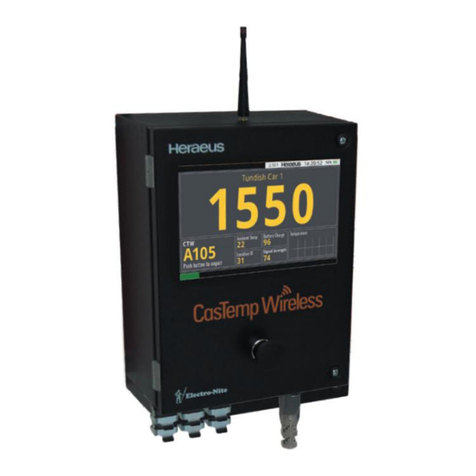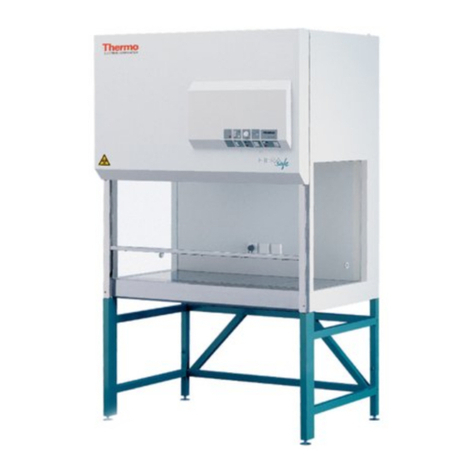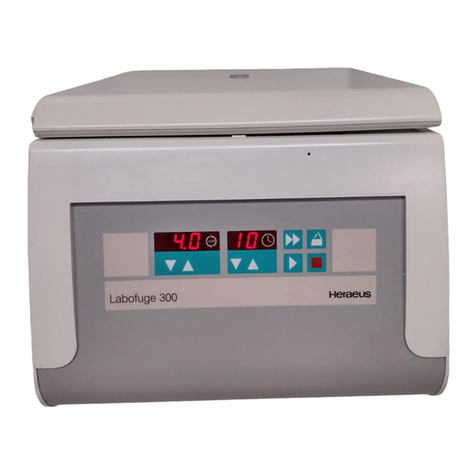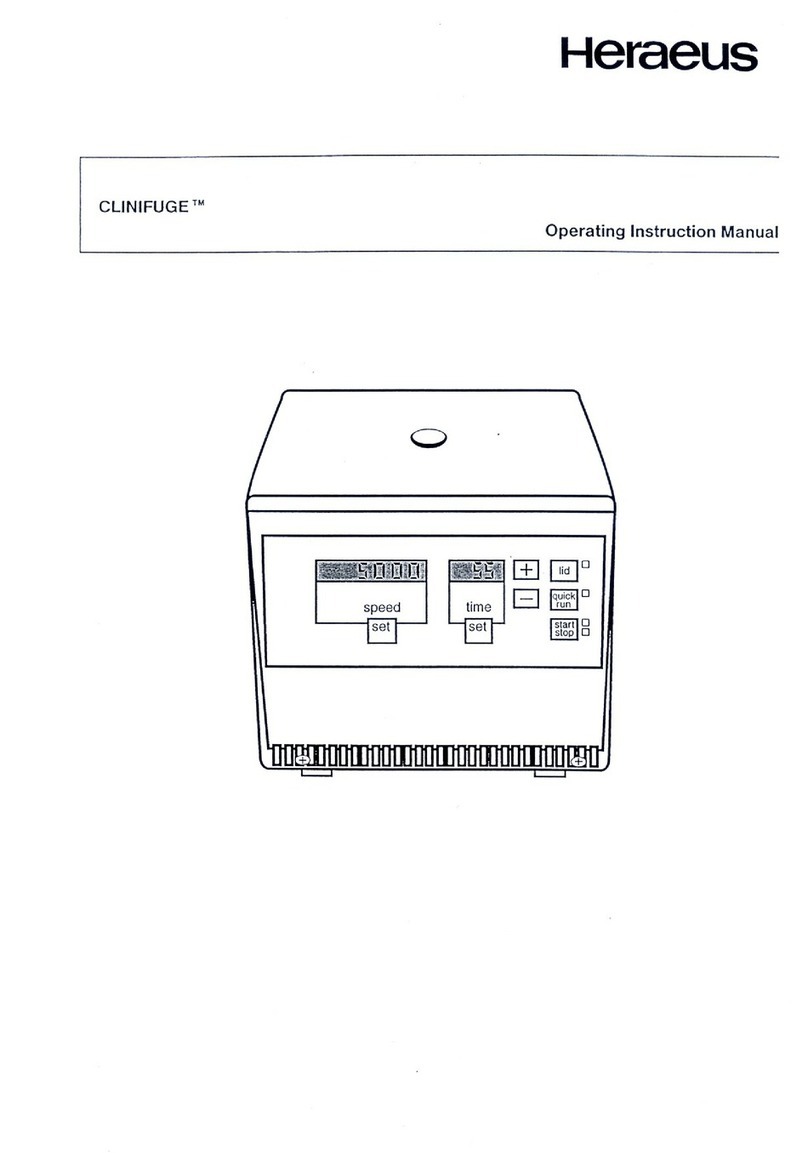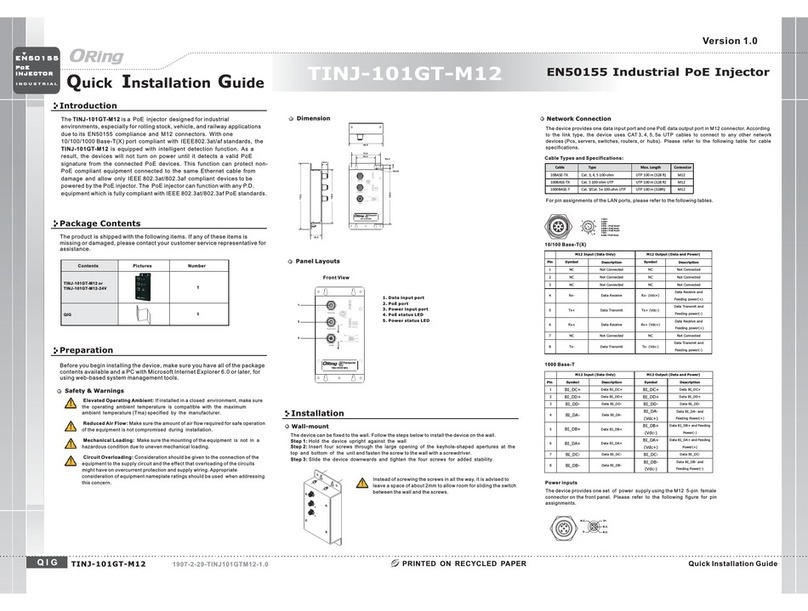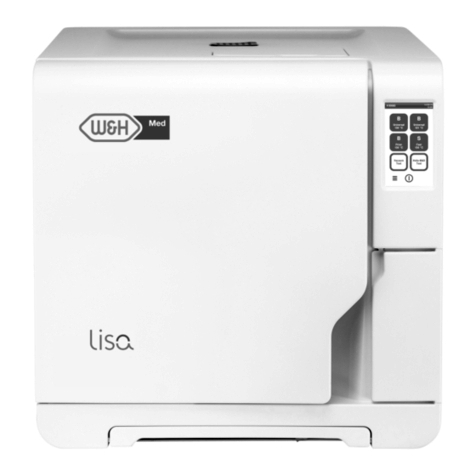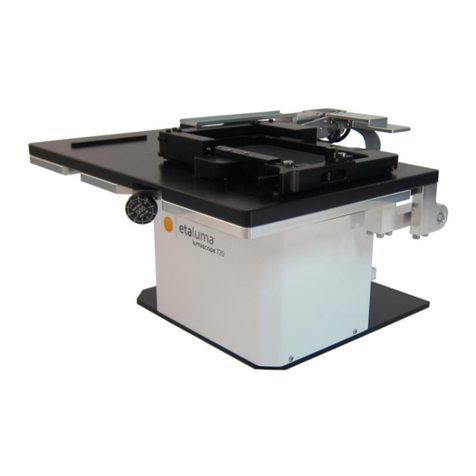Heraeus LABOFUGE 400e User manual

LABOFUGE
400
Betriebsanleitung
LABOFUGE
400
LABOFUGE
400R
Operating
Instructions
Vor
Gebrauch
lesen!
Read
before
usage!

VORSICHTSMASSNAHMEN:
UND
GEFAHREN
“|
Lesen
Sie
die
Betriebsanleitung
vor
Inbetriebnahme
der
Zentrifuge
aufmerksam
durch!
Diese
Zentrifuge
darf
nicht
von
Personen
in
Betrieb
genommen
werden,
die
nicht
mit
Ihrem
kotrekten
Gebrauch
vertraut
sind.
-
Vermeiden
Sie
Schäden
am
Geràt
oder
ZubehGrieilen
durch
Fehlbedienung!
-
Verfahren
Sie
bei
eventuellen
St6rungen
genau
nach
Vorschrift
(siehe
11.
Stórungsanalyse)!
-
Fúr
den
Transport
muf
der
Rotor
ausgebaut
sein!
+
Verwenden
Sie
nur
Original-Ersatzteile!
ACHTUNG
-
GEFAHRI
Beachten
Sie
zum
Schutz
von
Personen
und
Umwelt
die
folgenden
SicherheitsmaRnahmen:
-
Betrieb
der
Zentrifuge
in
explosionsgefährdeten
Bereichen.
Die
LABOFUGEN
sind
weder
ex-geschützt
noch
inertisiert.
+
Während
des
Zentrifugierens
ist
der
Aufenthalt
von
Personen
oder
gefahrlichen
Stoffen
innerhalb
der
30cm
Sicherheitszone
um
das
Gerat
herum
verboten!
-
Das
Zentrifugieren
von
radioaktiven
oder
brennbaren
oder
explosiven
oder
soichen
Stoffen,
die
chemisch
mit
hoher
Energie
miteinander
reagieren,
ist
ohne
geeignete
Sicherheitssysteme
(z.B.
Schutzkammern)
verboten!
-
Beim
Zentrifugieren
von
Toxiden
oder
pathogenen
Mikro-
organismen
ohne
geeignete
Sicherheitssysteme
ist
es
verboten
GefaRe
ohne
(oder
mit
defekten)
BIOABDICH-
TUNGEN
zu
verwenden.
Der
Anwender
ist
verpflichtet,
geeignete
©
Desifektionsmafknahmen
durchzuftihren,
falis
Gefahrenstoffe
in
das
Gerát
oder
Teilen
davon
gelangt
sind!
+
Offnen
Sie
unter
keinen
Umstánden
den
Deckel
manuell,
wenn
sich
der
Rotor
noch
dreht.
・
Es
ist
verboten,
einen
anderen
als
den
eingesetzten
Rotor
oder
Becher
zu
programmieren
(siehe
7.2.1).
SchlieRen
Sie
unzulássige
Betriebsweisen
aus, wie:
・
Nicht
fachgerecht
installierte
Zentrifuge.
・
Betrieb
mit
abgenommener
Verkieidung
oder
Teilen
davon.
・
Betrieb
der
Zentrifuge
nach
Eingriffen
in
mechanische
oder
elektrische
Baugruppen
durch
nicht.
autorisierte
Personen.
-
Start
der
Zentrifuge
mit
einem
nicht
zulássigen
Rotor.
・
Betrieb
der
Zentrifuge
mit
teilweise
leeren
Gehangeplatzen
oder
falsch
eingesetzten
Bechern.
-
Úberladung
des
Rotors
-
Uberschreiten
des
fiir
eine
bestimmte
Drehzahl
zulässigen
Maximalgewichtes
der
Schwenkbecher
(mit
Beladung).
+
Zentrifugation
stark
korrodierender
Substanzen,
die
Material-
schaden
verursachen
und
die
die
mechanische
Festigkeit
von
Rotoren
und
Schwenkgefa&en
vermindern
kónnen,
ohne
ausreichende
SchutzmaBnahmen.
・
Betrieb
der
Zentrifuge
mit
Rotoren
und
Bechern,
die
bereits
deutliche
Korrosionsspuren
oder
mechanische
Schäden
aufweisen.
-
Verwendung
von
Rotoren
und Zubehôürteilen,
die
nicht
aus-
drůcklich
von
der
Fa.
Kendro
Laboratory
Products
zugelassen
sind,
mit
Ausnahme
der
handelsiiblichen
ZentrifugiergefáBe
aus
Glas
oder
Kunststoff!
Der
Hersteller
betrachtet
sich
nur
dann
fiir
die
Sicherheit,
Zuverlässigkeit
und
Leistung
des
Gerátes
verantwortlich,
wenn:
-
das
Gerát
in
Úbereinstimmung
mit
der
Gebrauchsanweisung
verwendet
wird
und
-
Montage,
Erweiterungen,
Neueinstellungen,
Anderungen
oder
Reparaturen
durch
von
ihm
ermachtigte
Personen
ausgefthrt
werden,
und
die
elektrische
Installation
des
betreffenden
Rau-
mes
den
Anforderungen
von
IEC-Festlegungen
entspricht.
ACHTUNG!
Beim
Zentrifugieren
mit
infektiôsen
Substanzen
mussen
die
allgemeinen
Labor-Sicherheitsmaknahmen
beachtet
werden!
Wenden
Sie
Sich
an
Ihren
Sicherheitsbeauftragten!
[
PRECAUTIONS:
AND
HAZARDS
Before
attempting
to
operate
the
centrifuge
read
all
parts
of
this
manual
carefully
to
insure
smooth
operation
and
avoid
damage
to
the
unit
or
its
accessories.
if
a
malfunction
occurs, consult
the
Troubleshooting
Guide
at
the
end
of
this
manual.
if
problems
persist,
call
your
nearest
KENDRO
Service
Department
or
its
accredited
Agency.
The
centrifuge
must
not
be
operated
by
unqualified
‘personnel!
-
Avoid
causing
damage
to
the
unit
or
its
accessories
through
incorrect
operation!
-
Never
transport
the
centrifuge
with
a
rotor
installed
on
its
shaft!
Use
only
original
adapters,
tubes
and
spare
parts!
ATTENTION
-
DANGER!
For
personal
and
environmental
safety
pay
attention
to
the
following
features:
・
Do
not
operate
the
centrifuge
in
explosion-hazardous
locations!
The
LABOFUGES
are
neither
explosion-proof
nor
inert
gas
shielded.
-
Never
stay
in
the
safety
zone
of
30cm
around
the
centrifuge
hor
deposit
dangerous
goods
inside
this
zone
during
centrifugation!
-
Do
not
spin
samples
which
can
create
flammable
or
explosive
mixtures
when
exposed
to
air,
unless
adequate
safety
precautions
have
been
taken
(e.g.
shelter)!
ㆍ
Never
spin
toxical
or
pathological
material
without
or
with
defective
hermetic
sealing,
unless
adequate
safety
precautions
have been
taken
(e.g.
shelter}!
Adequate
disinfecting
procedures
must
be
performed,
if
dangerous
goods
have
contaminated
the
centrifuge
or
its
accessories.
+
Never
open
the
lid
manually
while
the
rotor
is
spinning!
+
It
is
forbidden
to
program
a
rotor
or
bucket
type,
which
is
not
physically
installed
(see
7.2.1)!
The
following
rules
must
be
strictly
observed:
+
Never
operate
the
centrifuge
if
it
is
not
correctly
installed
or
its
drive shaft
is
damaged.
-
Do
not
operate
the
centrifuge
with
any
parts
or
covers
removed.
-
Never
run
the
centrifuge
when
the
electrical
or
mechanical
equipment
have been
tampered
with
by
unauthorized
or
unskilled
personnel.
-
Never
attempt
to
run the
centrifuge
with
an
incorrectly
installed
or
unauthorized
rotor.
+
Do
not
operate
the
centrifuge
with
incorrectly
installed
or
partial
removed
buckets.
-
The
maximum
rotor
load
and
speed
must
be
observed!
-
Do
not
spin
corrosive
sampies
which
may
impair
the
material
strength
of
the
rotors
and
buckets
without
taking
all
necessary
precautions
(e.g.
sealed
tubes).
+
Never
use
accessories
(rotors
or
buckets) which
show
noticeable
traces
of
corrosion
or
mechanical
damage.
-
Do
not
use
accessories
which
are
not
approved
by
Kendro
Laboratory
Products,
except
commercially
available
centrifuge
tubes
of
glass
or
plastic.
The
manifacturer
is
only
responsible
for
the
security,
reliability
and
performance
of
the
unit,
if
-
the
unit
is
operated
in
accordance
with
the
operating
instructions
-
installations,
expansions,
new
adjustments,
changes
or
repairs
are
performed
only
by
KENDRO
authorized
persons.
NOTE:
When
performing
centrifugation
and
other
functions
which
may
expose
workers
to
splashed
blood
or
body
fluids,
all
laboratory
personnel
must
follow
universal
laboratory
precautions.
For
details
contact
your
local
laboratory
safety
officer.

ANLEITUNG
ZUR:
SCHNELL4NBETRIEBNAHME
|
Aufstellen
der
Zentrifuge
1.
7.
8.
Gerát
beidseitig
transportieren
und
auf
einem
stabilen,
reso-
nanzfreien
Unterbau
in
gut
belůfteter,
vor
Sonneneinstrah-
lung
geschůtzter,
Umgebung
aufstellen
und
einen
30cm
breiten
Sicherheitsabstand
um
die
Zentrifuge
herum
mar-
kieren
(siehe
4.)
Überprüfung
der
verfügbaren
Netzspannung
und
Frequenz
mit
den
Typenschild-Angaben
(4.2)
Netzstecker
eindrücken
und
Gerate-ldentifikationsanzeige
abwarten
Aufleuchten
der
gelben
LED
rechts
neben
der
Deckel-Taste
"lid"
abwarten,
Taste
drticken
und
Deckel
von
Hand
anhe-
ben,
Deckel
óffnet
selbsttátig,
sámtliches
Verpackungsmate-
rial
und
Zubehór
(Rotorbefestigungsmutter,
Steckschlússel
usw.)
aus
dem
Gehe
(Rotorkammer)
entnehmen
Rotor
auspacken
und
so
auf
die
Antriebswelfe
stecken,
das
der
Mitnehmerstift
genau
in
den
Rotorschlitz
paRt
(siehe
4.3).
Rotor-Hutmutter
mit
mitgeliefertem
Steckschlússel
auf
der
Antriebswelle
festschrauben
(siehe
5.1)
Rotor
MUR
sich
frei
drehen
lassen!
Beim
Ausschwing-Rotor
mússen
alle
Einhángebolzen
gefettet
und
alle
4
Becher
eingesetzt
werden
und
vom
selben
Typ
und
der
selben
Gewichtsklasse
sein
(6.1)!
Die
Beladung
(zulássige
Werte
siehe
13.)
der
Becher
muB
symmetrisch
erfolgen
(siehe
6.2)!
Deckel
fest
zudrůcken
aber
nicht
zuschlagen.
Die
"Open"-
Anzeige
verschwindet
bei
korrekt
verschlossenem
Deckel.
Programmierung
des
ersten
Laufes
9.
10.
11.
12.
43.
Best.-Nr.
des
eingesetzten
Rotors
oder
der
Becher
vorwáhlen:
"set"-Taste
des
"time/rotor"-Feldes
einmal
kurz
drücken
(Einstell-Position
blinkt),
danach
ein
2.
Mal
für
den
gesamten
Einstellvorgang
gedrückt
halten
("ro"-Anzeige).
Im
"speed/rcf-Feld
blinkt
die
zuletzt
eingestellte
Rotor
Best.-
Nr.,
die
jetzt
mit
den
gelben
"+"-
und
"-"-Tasten
verándert
werden.
Bei
Gleichheit
von
blinkender
und
eingesetzter
Rotor
oder
Becher-Nr.
(ist
auf
allen
Bechern
eingraviert)
wird
die
Einstellung
mit
dem
Loslassen
der
"set"-Taste
abgeschlos-
sen
(7.2.1).
WARNUNG!
Es
muf
immer
die
Best-Nr.
des
tatsáchlich
eingesetzten
Rotors
oder
der
Becher
programmiert
werden,
sonst
kann
es
zur
Zerstórung
des
Gerátes
durch
faische
Drehzahl-Einsteliungen
kommen!
Drehzahi
einstellen:
“set'-Taste
des
"speed/rcf'-Feldes
drücken
und
blinkenden
Drehzahi-Anzeigewert
(in
100
min”)
mit
den
geiben
“+"-
und
"-"-Tasten
eingestelten
und
zur
Bestátigung
ein
zweites
Mal
drůcken
(fůr
Einstellung
des
RZB-Wertes
siehe
7.2.3).
Laufzeit
vorwáhlen:
"set"-Taste
des
"time/rotor"-Feldes
drůcken
und
blinkenden
Anzeigenwert
in
Minuten
mit
den
"+"
und
"-"-Tasten
einstellen,
zur
Beendigung
"set"-Taste
ein
zweites
Mal
drůcken
(7.2.5).
Temperatur
einstellen
(nur
LABOFUGE
400R):
"set"-Taste
des
"temp"-Feldes
driicken
und
blinkenden
Anzeigewert
in
°C
analog
zur
Drehzahi-
oder
Laufzeit-Einstellung
verándern
(7.2.6).
Zentrifugen-Lauf
starten:
Doppelfunktionstaste
"start/stop"
drucken,
langsame
oder
schnelle
Beschleunigung
ist
mit
der
"brake"-Taste
umschaltbar
(7.1.5);
nach
Ablauf
der
programmierten
Zeit
wird
die
Zentrifugation
automatisch
beendet.
Für
vorzeitigen
Abbruch
erneut
die
"start/stop"-
Taste
drücken.
Vorbereitung
für
den
nächsten
Lauf
14.
15.
Freigabe
für
Deckel-Taste
abwarten
(gelbe
LED)
,
"lid"-Taste
drücken,
Deckel
6ffnen
und
vor
dem
Herausnehmen
den
Zustand
der
Gefa&e
überprüfen.
Gefafe
auf
Bruch,
Gehe,
Rotor
und
Einse
auf
auslaufende
Flůssigkeit
hin
úberprůfen,
ggf.reinigen
oder
desinfizieren
(náheres
siehe
10.1
und
fůr
Desinfektion
10.2).
Náhere
Informationen
sind
in
den
angegebenen
Kapiteln
nachzulesen!
FAST
START
UP
AND
REFERENCE
GUIDE
Setting
up
the
Centrifuge
1.
Transport
the
unit
on
both
sides
and
set
it
on
a
flat
sturdy,
resonance-free
surface
in
a
well
ventilated
area
(without
exposicn
to
heat
emitting
objects)
and
mark
a
safety
zone
of
30
cm
around
it
(Details
in
Section
4)
Insure
the
mains
supply
available
is
equal
(in
voltage
and
frequency)
with
the
required
on
identification
piate
(see
Electrical
Requirements,
Section
4.2).
Plug
the
mains
cable
into
the
adequate
wall
socket
and,
if
optional
available,
turn
on
the
main
power
switch
located
under
the
bottom
plate
right
side.
Wait
for
the
illumination
of
the
yellow
LED
next
to
the
"lid"
key.
Open
the
lid
by
pressing
the
"lid"
keypad
and
remove
all
packing
materials
and
accessories
(rotor
locking
nut
and
socket
wrench
for
rotor
fixing).
Remove
the
rotor
packaging
(4.3),
mount
it
on
the
drive
shaft,
alligning
the
groove
on
the rotor's
underside
with
the
cross
pin
in
the
drive
shaft.
Screw
locking
nut
in
place
(see
Installing
Rotors
5.1}.
Rotor
must
move
freely!
When
installing
the
swing-out
rotor
all
trunninons
must
be
greased
and
all 4
buckets
of
the
same
type
and
weight
must
be
occupied
(6.1)!
Load
all
adaptors
(for
maximum
load
see
Section
13.)
and
tubes
making
sure
the
rotor
is
symmetrically
balanced
(see
Section
6.2).
Close
the
lid
firmly
on
both
sides,
but
do
nut
slam
it.
The
"Open"
message
will
disappear,
if
the
lid
is
closed
correctly.
Programming
the
First
Run
9.
10.
11.
12.
13.
To
set
the
Cat.
No.
of
the
installed
rotor
or
buckets
press
the
"set"-key
of
the
"time/rotor“
field
once
and
then
press
again
and keep
it
pressed
for
the
whole
setting
procedure.
The
rotor
sign
"ro"
will
appear
and
the
flashing
Cat.
No.
shown
in
the
"speed/rcf"
field
can
now
be
changed
by
using
the
yellow
"+"
or
"-"
keys.
If
the
flashing
Cat.
No.
is
equal
with
the
installed
one
(verify
with
No.
imprinted
on
inserted
rotor
or
bucket
type),
rotor
setting
is
terminated
on
releasing
the
"set”-key
(7.2.1).
WARNING!
Always
program
the
Cat.
No.
of
the
really
installed
rotor
or
buckets,
otherwise
the
maximum
allowed
bucket
speed
can
be
overwritten
and
damage
to
persons
and
property
may
result.
To
set
speed
for
a
timed
run,
press
the
"set"
key
of
the
“speed/rcf'
field
Change
the
flashing
digit
by
using
the
"+"
or
"-"
keys
in
steps
of
100
rpm
and
for
termination
press
the
"set"
key
a
second
time
(for
setting
RCF
instead
of
SPEED
values
see
7.2.3).
To
set
time, press
the
"set"
keypad
of
"time/rotor"
fieid.
Change
the
flashing
time
value
(in
minutes)
analogously
to
speed
setting
with
"+"
/"-"
keys
and
terminate
the
procedure
by
pressing
"set"
key
a
second
time
(7.2.5).
LABOFUGE
400R
only: To
set
temperature,
press
the
"set"
keypad
of
the
temp
field
and
change
the
temperature
value
(in
°C)
analogousiy
to
the
speed
and
time
setting
(7.6.4).
To
start
the
centrifugation,
press
the
dual
function
"start/stop"
key.
Slow
and
fast
acceleration
can
be
toggled
with
the
"brake"
key
at
any
time
(7.1.5).
After
termination
of
the
programmed
time,
unit
will
shut
off
automatically.
For
premature
termination
of
the
centrifugal
run
press
the
"start/stop"
key
again.
Preparing
the
next
run
14.
15.
Wait
for
release
of
“lid”
key
(yellow
LED
indicates
end
of
cycle),
open
the
lid
and
check
the
condition
of
all
bags
or
tubes
before
removing
them
from
rotor.
Check
for
broken
glass
or
leakage
into
rotor,
buckets
and/or
chamber
(for
ceaning
see
10.1,
for
disinfecting
10.2)
For
more
detailed
information,
operation
and
guidelines,
consult
the
other
marked
sections
of
this
manual.

INHALTSVERZEICHNIS
η
VORSICHTSMASSNAHMEN
UND
GEFAHREN
............
2
ANLEITUNG
ZUR
SCHNELL-INBETRIEBNAHME
..........
3
1.
GERÂTE-BESCHREIBUNG
...........................
6
1.1
Klassifizierung
1.2
Definition
1.3
Konformitát
mit
Normen
und
Vorschriften
1.4
Garantie
............................................
7
1.5
Zubehör
2.
TECHNISCHEDATEN
.................................
8
24
2.2
2.3
2.4
Gemeinsame
Leistungsmerkmale
Spezielle
Daten
LABOFUGE
400e
/
400
Spezielle
Daten
LABOFUGE
400R
.................
9
“MEGACONTROL"-
Merkmale
3.
SICHERHEITSEINRICHTUNGEN
3.1
Rotorkammer
3.2
Deckelverriegelung
3.3
Thermischer
Motor-
und
Elektronik-Schutz
3.4
Unwuchtschalter
3.5
Beschleunigungsprüfung
3.6
Deckel-Notôffnung
3.7
Übertemperatur-Schutz
4.
INSTALLATION
4.1
Aufstellen
4.2
Netzanschlu&
vornehmen
4.3
Inbetriebnehmen
4.4
Deckel
ôffnen
5.
ROTOR
EIN-
UND
AUSBAUEN
5.1
Einsetzen
der
Rotoren
5.2
Einfetten
der
Schwenklager-Bolzen
5.3
Rotor
Deckel
5.4
Rofor
herausnehmen
6.
BELADEN
DES
ROTORS
6.1
Becher-Plätze
6.2
Symmetrische
Beladung
6.3
Befüllung
der
Rôhrchen
6.4
Zulässige
Unwucht
6.5
Teilbeladung
6.6
Maximale
Beladung
7.
“MEGACONTROL"-PROGRAMMIERUNG
TA
7.1.1
7.1.2
7.1.3
7.1.4
7.1.5
7.2
7.2.1
7.2.2
7.2.3
7.2.4
7.2.5
7.2.6
Tasten
fiir
Ablauf-Steuerung
Deckel
öffnen
("iid")
Zentrifugenlauf
starten
("start")
Zentrifugenlauf
beenden
("stop")
Kurzzeitiges
Zentrifugieren
(“quick
run")
Langsames
Beschleunigen
und
Abbremsen
("brake")
Programmierung
der
Zentrifugierparameter
Rotor-/Becher-Vorwahi
("rotor")
Drehzahi-Vorwahi
("speed")
RZB-Vorwahi
("ref")
Bremsabschalt-Drehzahl-Vorwahi
(“set"
+
"brake”)
...
21
Zeit-Vorwahl
("time")
Temperatur-Vorwahl
("temp"
nur
far
LABOFUGE
400R)
READ
ME
FIRST
FAST
START
UP
AND
REFERENCE
GUIDE
1.
11
1.2
13
1.4
1.5
TABLE
OF
CONTENTS
DESCRIPTION
Classification
Definition
Conformity
of
Standards
and
Regulations
Warranty
Standard
Accessories
2.
ТЕСНМЮСАЁ
ВАТА
...............
иене
8
2.1
2.2
2.3
2.4
3
31
3.2
33
3.4
3.5
3.6
3.7
4.
41
42
43
44
5.
5.1
5.2
5.3
5.4
6.
6.1
6.2
6.3
6.4
6.5
6.6
7.
7A
7.1.1
7.1.2
7,1.3
7.1.4
7.1.5
7.2
7.2.1
7.2.2
7.2.3
7.2.4
7.2.5
7.2.6
Common
Features
Special
Data
of
LABOFUGE
400e
/
400
Special
Data
of
LABOFUGE
400R
"MEGACONTROL"
-
Features
SAFETY
SYSTEMS
Rotor
Chamber
lid
Lock
Thermal
Motor
and
Electronics
Protection
imbalance
Switch
Check
of
Acceleration
Rate
Emergency
Lid
Release
..............................
11
Overtemperature
Protection
INSTALLATION
Location
Electrical
Requirements
Energizing
Opening
the
lid
ROTOR
INSTALLATION
AND
REMOVAL
Rotor
Mounting
Greasing
of
Rotor
Trunnions
....
Rotor
Cover
Rotor
Removal
ROTOR
LOADING
Bucket
Positions
Symmetrical
Charge
Tube
Filling
Permissible
Imbalance
Partial
Load
Loading
Limits
"MEGACONTROL"
PROGRAMMING
Control
Keys
Lid
Start
Stop
Quick
Run
Smooth
Acceleration
and
Deceleration
("brake")
Programming
Rotor
or
Bucket
Selection
("rotor")
Speed
Selection
RCF
Selection
Brake
Cut-out
Speed
(“set"
+
"brake")
Time
Selection
Temperature
Selection
(“temp"
only
LABOFUGE
400R)

INHAL
TSVERZEICHNIS
|||
TABLE
OF
CONTENTS
7.3
Anzeige-Funktionen
.................................
22
|
7.3
Displaying
Functions
...............................
22
7.3.1
Drehzahi
("speed")
7.3.1
Speed
7.32
Relativer
Zentrifugal-Beiwert
("ref")
7.3.2
Relatively
Centrifugal
Force
("ref")
7.3.3
Zeit
("time")
7.3.3
Time
7.3.4
Rotor-/Becher-Best.
Nr.
("rotor")
7.3.4.
Rotor
or
Bucket
Cat.
No.
(“rotor”)
7.3.5.
Proben-Temperatur
("temp"
nur
LABOFUGE
400R)
7.3.5
Sample
Temperature
("temp“
only
LABOFUGE
400R)
7.3.6
Standby-Betrieb
7.3.6
Standby-Operation
8.
BESCHLEUNIGUNGS-
UND
BREMSKURVEN
...
..
23
|
8.
ACCELERATION
AND
BRAKING
PROFILES
...........
23
8.1
Konzeption
der
Kurven
8.1
Profile
Principles
8.2
Auswahl
der
Kurven
8.2
Selection
of
Profiles
8.3
Wirbelbildung
beim
Abbremsen
(Ausschwing-Rotoren)
8.3
Turbulence
during
Deceleration
(Swing-out
rotors)
8.4
Bremseinstellung
bei
empfindlichen
Proben
8.4
Brake
Settings
for
Delicate
Samples
9.
HINWEISE
ZUM
TEMPERATURVERHALTEN
...........
24
|
9.
TEMPERATURE
FEATURES
...........................
24
9.1
LABOFUGE
400e
/
400
9.1
LABOFUGE
400e
/
400
mit
direkter
/
indirekter
Luftkiihlung
with
Direct
or
Indirect
Air
Cooling
9.1.1
Ermittlung
einer
Drehzahl
-
Temperatur-Tabelle
9.1.1.
Preparing
a
Speed
-
Temperature
Chard
9.1.2
Temperaturempfindliche
Proben
9.1.2
Thermo-delicate
Samples
9.2
Temperatur-Regelung
LABOFUGE
400R
............
25
|
9.2
Temperature
Control
LABOFUGE
400R
............
25
9.2.1
Vorktihlen
oder
Vorwarmen
des
Rotors
9.2.1
Pre-cooling
or
Pre-heating
of
Rotors
9.2.2
Vorkúhlen
oder
Vorwármen
mit
Proben
9.2.2
Pre-cooling
or
Pre-heating
with
Samples
10.
WARTUNG
UND
PFLEGE
............................
26
|
10.
MAINTENANCE
AND
CARE
..........................
26
10.1
Reinigung
10.1
Cleaning
10.2
Desinfektion
10.2
Disinfection
10.3
Lagerschmierung
ーー
ーー
トード
ーーーーー
27
|
10.3
Greasing
............................................
27
40.4
Glasbruch
10.4
Glass
Breakage
10.5
Kondensatbildung
10.5
Condensed
Water
10.6
Wartungsplan
......................................
28
|
10.6
Servicing
Schedule
.................................
28
11.
STÖRUNGSANALYSE
................................
29
¡
11.
TROUBLE
SHOOTING
¿ooo
coccion
29
11.1
MaBnahmen
zur
Selbsthilfe
11.1
Measures
to
Do-it-yourself
11.2
Service-Einsatz
....................................
32
|
11.2
Servicing
12.
TYPENSCHILD
ANGABEN
13.
ROTOR/
BECHER
TABELLE
12.
IDENTIFICATION
OF
UNITS
13.
ROTOR/BUCKET
TABLE

1.
GERATE-BESCHREIBUNG
|
1.1
Klassifizierung
Die
LABOFUGEN
400e
/
400
/
400R
sind
technisch
hochentwickelte,
mikroprozessorgesteuerte
Laborzentri-
fugen
mit
frequenzgesteuertem
und
wartungsfreiem
Induktionsantrieb.
Sie
sind
als
Tischmodelle
für
umfangreiches
Zubeh6r
konzipiert
und
gehören
zur
Gruppe
3
nach
der
Medizingerateverordnung
(Med
GV).
1.2
Definition
Die
LABOFUGEN
400
/
400R
sind
auf
einer
vibrationsarmen,
massiven
Poiymerbeton-Bodenplatte
aufgebaut
(entfalit
bei
LABOFUGE
400e).
Das
Gehause
besteht
aus
einer
zweigeteiten
Stahiblechkonstruktion,
welches
die
Bodenplatte
komplett
umschlieRt.
Die
Frontverkleidung
ist
aus
Kunststoff
gefertigt
und
mit
einer
pflegeleichten
Folie
Uberklebt.
Gehäuse
und
Frontblende
sind
fest
miteinander
verschraubt.
Die
Rotoren
werden
direkt
von
einem frequenzgesteuer-
ten,
wartungsfreien
Induktionsmotor
mit
hoher
Beschleu-
nigungsleistung
angetrieben.
Dieser
Antrieb
sorgt
für
geräusch-
und
vibrationsarmen
Lauf,
auch
bei
hohen
Drehzahlen,
und
erreicht
eine
sehr
hohe
Lebensdauer.
Er
ist
schwingungsdámpfend
auf
der
Bodenplatte
befestigt
und
Uber
einen
Gummiflansch
zur
Rotorkammer
abge-
dichtet.
Der
Zentralprozessor
überwacht
die
Ablauf-
steuerung,
die
Drehzahl-Messung
und
-Regelung,
die
Temperatur-Messung
und
-Regelung
(nur
LABOFUGEN
400R),
die
Sicherheitssysteme
und
die
Stórungsmel-
dungen
der
Zentrifuge.
Ein
zusätzlicher
Mikroprozessor
ist
für
die
Tasten-
und
Anzeigen-Funktionen
zustândig.
Für
Bedienung
und
Programmierung
der
Zentrifugen
dient
das
anwender-
freundliche
MEGACONTROL
-
System
(s.
Abschnitt
7.)
LABOFUGE
400e
Bei
der
Ekonomie-Version
tritt
der
Luftstrom
bei
drehendem
Motor
von
hinten
durch
einen
Spalt
in
der
Deckeldichtung
ein,
kiihlt
den
Rotor
und verlâRi
die
Zentrifuge
wieder
durch
diese
Offnung.
LABOFUGE
400
Der
Kiihl-Luftstrom
wird
von
2
leistungsstarken
Ventilato-
ren
in
der
Geráte-Rúckwand
aufgebracht.
LABOFUGE
400R
Dieses
Gerát
enthált
zur
Temperatur-Regelung
des
Zentrifugiergutes
eine
Kompressor-Anlage
mit
FCKW-
freiem
Káltemittel
(siehe
9.2).
1.3
Konformitát
mit
Normen
und
Vorschriften
Diese
Geráte
werden
in
Ubereinstimmung
mit
den
foigenden
giiltigen
Normen
hergestellt und
gepriift:
national
+
Funk
Entstérung
nach
VDE
0871
(B)
«
DIN
58
970,
Teil
2
für
Laborzentrifugen
+
DIN
57
700,
Teil
1
/
VDE
0700
Teil
1
international
+
elektrische
Sicherheit
nach
1010-2-D
+
IEC 335-1
/
IEC
66E(CO)11
*
PREN
61
010-1,
PR
EN
61
010-2-2
IEC
1010-1
und
IEC
11.
DESCRIPTION
|
4.1
Classification
The
LABOFUGES
400e
/
400
/
400R
are
designed
to
perform
a
variety
of
separation
tasks
in
small-scale
laboratories.
All
units
are
constructed
as
bench-top
models
with
an
extensive
range
of
accessories,
micoprocessor-controlled
and
equipped
with
a
maintanance-free
induction
drive.
1.2
Definition
The
LABOFUGES
400
/
400R
have
a
low
vibration
solid
polymer
bottom
plate
(be
wasted
on
LABOFUGE
400e)
The
housing
is
build
of
a
two-pieced
sheet
steel
and
surrounds
the
bottom
plate
completely.
The
front
panal
is
made
of
a
resistant
plastic
material
on
which
an
easy
cleanable
foil
is
glued.
Housing
and
front
panal
are
fixed
tightly
together
by
srews.
The
rotors
of
all
three
units are
started
directly
with
a
frequency
controlled
and
maintance-free
induction
drive
(brushless)
with
high
acceleration
power.
This
drive
ensures
noiseless,
low
vibration
running
at
high
speed
with
high
reliability.
The
drive
is
mounted
with
shock
absorbers
to
the
bottom
plate
and
sealed
with
a
rubber
flange
to
the
rotor
chamber.
The
central
processor
manages
the
controlling,
the
functions
for
speed
measuring
and
regulation,
the
temperature
measuring
and
regulation
(only
LABOFUGE
400R),
safety
contro!
and
error
coding.
An
additional
microprocessor
is
responsible
for
the
key
and display
functions.
The
centrifuge
is
controlled
by
the
user
friendly
"MEGACONTROL”
system
(see
section
7.)
LABOFUGE
400e
The
air
flow,
drawn
in
through
the
motor
covers
vent
holes,
cools
the rotor
and
is
discharged
from
the
centrifuge
via
the
outlet
of
the
lid
sealing.
LABOFUGE
400
The
cooling
air
flow
is
performed
by
2
powerful
fans
mounted
on
the
rear
casing.
LABOFUGE
400R
This
units
is
equipped
with
a
compressor
plant
filled
with
CFC-free
refrigerant
for
temperature
control
(see
section
9.2)
1.3
Conformity
of
Standards
and
Regulations
These
products
are
manufactured
and
tested
in
accordance
with
the
following
current
standards:
German
standards
-
Electrical
noise
suppression
according
to
VDE
0871
grade
B
ㆍ
DIN
58
970,
part
2
for
laboratory
centrifuges
+
DIN
57
700,
part
1 /
VDE
700
part
1
international
standards
ㆍ
Electrical
safety
according
to
IEC
1010-1
and
IEC
1010-2-D
+
IEC
335-1
/
IEC
66E(CO)11
-
PREN
61
010-1,
PR
EN
61
010-2-2

|
GERATE-BESCHREIBUNG
| |
DESCRIPTION
Vorschriften
-
Unfaliverhütungsvorschrift
für
elektrische
Anlagen
und
Beiriebsmittel
UVV
VBG
4
ㆍ
Unfallverhütungsvorschrift
für
Kálteanlagen
nach
UVV
VBG
20
(nur
LABOFUGE
400R)
Sicherheitsprůfungen
sind
nach
GS
erfoigt.
1.4
Garantie
Die
Garantiezeit
beginnt
mit
dem
Tag
der
Anlieferung.
Innerhalb
der
Garantiefrist
wird
die
Zentrifuge
kostenlos
repariert
oder
ersetzt,
wenn
nachweisliche
Verarbeitungs-
oder
Materialfehler
auftreten.
1.5
Zubehór
Zur
Rotorbefestigung
ist
eine
spezielle
Hutmutter
(Ersatzteil-Nr.
20054407)
erforderlich,
die
zusammen
mit
einem
6
mm-Rohrsteckschlüssel
Lieferumfang
gehört
(siehe
Abb.
1).
Ferner
sind
50
ml
Korrosionsschutzôl
(#70001824)
zur
Pflege
der
metallischen
Rotor- und
Becher-Oberflachen
und
eine
Dose
Fett
(#70006692)
zur
Schmierung
der
Einhángebolzen
des
Ausschwingrotors
(siehe
10.3)
mitgeliefert.
Zu
den
Dokumenten
gehóren:
-
ein
Prospekt/Katalog
mit
allem
verfiigbaren
Zubehôr
+
die
Gerauchsanweisung
-
eine
Garantie-Karte
-
eine
Plastik-Tasche
zur
Aufbewahrung
aller
schrift-
lichen
Unterlagen
(sollte
stets
dem
Gerát
beiliegen)
(#20360047)
zum
|
Regulations
-
Accident
prevention
regulations
for
electrical
plants
and
supplies
UVV
VBG
4.
-
Accident
preventation
regulations
for
cooling
units,
UVV
VBG
20
(only
LABOFUGE
400R).
Safety
inspections
according
to
GS
or
CSA,
NRTL/C.
1.4
Warranty
The
warranty
period
starts
with
the
day
of
delivery.
Within
the
warranty
period
the
centrifuge
is
repaired
or
repla-
ced
free
of
cost
if
there
are
demonstrable
faults
in
mateřials
or
workmanship.
1.5
Standard
Accessories
The
centrifuges
are
supplied
with
a
special
rotor
locking
nut
(Spare
Part
No.
#20054407)
and
a
6mm
socket
wrench
(#20360047)
to
fasten
the
rotors
(see
Fig.
1).
50
ml
of
anti-corrosive
oil
(Spare
Part
No.
470009824)
to
protect
the
metallic
surface
of
rotors
and
buckets
and
a
small
vial
of
special
grease
(Spare
Part
No.
#70006692)
to
coat
the
trunnions
of
swing
out
rotors
(see
10.3)
are
supplied
as
well.
Printed
documentation
supplied
are:
-
a
prospectus/catalogue
with
all
available
accessories
-
the
operating
instructions
+
a
warranty
registration
form
+
a
plastic
case
for
keeping
all
documents
(should
be
fastened
aside
the
centrifuge
6mm
Steckschlüssel
6mm
socket
wrench
Hutmutter
locking
nut
Typenschild
identification
label

2:
TECHNISCHE
DATEN
2.1
Gemeinsame
Leistungsmerkma!
(>.
TECHNICAL
DATA
2.1
Common
Features
iow
vibration
solid
polymer
bottom
Zudrücken
des
Deckels
Aufbau:.
vibrationsarme
Polymer-Bodenplatte
Base
construction:
(nicht
bel
LABOFUGE
400e)
plate
(exept
LABOFUGE
400e)
Geháuse:
Ober-
und
Unterteil
aus
Housing:
made
of
two
parts
of
sheet
steel,
fixed
einbrennlackierten
Stahlbiech,
thightly
by
screw
and
covered
with
volistândig
miteinander
verschraubt
annealing
color
Frontplatte:
Kunststoff-Gehause
fiir
Einbau
der
Operational
panel:
|synthetic
resin
for
incorporation
of
key
Tasten-
und
Anzeigen-Elemente,
mit
and
display
elements
covered
with
an
pflegeleichter
Schutzfolie
überzogen
easy
cleanable
membrane
Bedienung:
anwenderoptimiertes
MEGACONTROL
Operational
by
programming
of
the
user-friendly
-System
(siehe
2.2)
system:
MEGACONTROL
(features
see
2.2)
IAntrieb:
frequenzgesteuerter,
wartungsfreier
Drive:
frequency
controlled,
maitenance-free
Induktionsmotor
induction
motor
Rotorkammer:
aus
Edelstahi
Rotor
chamber:
made
of
stainless
steel
-Mañe
(S
x
H):
(377
x
187)mm
Dimension
(2
x
HJ:
(377
x
187)mm
(%"
x"
Deckel-Offnung:
elektromechanische
Entriegelung
über
Lid
Opening:
key button,
the
lid
pops
up
and
opens
Deckeltaste
bei
Spannungsversorgung
by
the
supporting
of
a
gas
lid
stay
Deckel-VerschiuR:
|selbstätige
Verriegelung
beim
Lid
Closing:
self-acting
by
pressing
the
lid
down
and
pushing
on
top
of
lid
lock
Deckel-Zuhaltung:
Doppelter
Sicherheitskreis
(Hard-
und
Software
Kontrolle)
Lid
Locking
at
run:
double
safty
circuit
(hard-
and
software
controlled)
Deckel-Notéffnung:
Entriegelung
bei
Spannungsausfali
über
Reifleine
durch
Bodenbiech
Lid
unlocking
in
case
of
emergency:
by
using
a
rip
cord
through
casing
hole
in
front
of
unit
Starten/Stoppen:
Doppelfunktionstaste
(Start-
bei
grüner,
Stop-Freigabe
bei
roter
LED)
Starting
/
Stopping:
dual
function
key
button
indicated
by
LED's
(start
at
green,
stop
at
red)
Start-Freigabe:
auch
wahrend
der
Bremsphase
Re-starting:
at
any
time
during
braking
phase
Schnell-Start/Stop:
"quick
run"
Dauerdruck-Taste
fúr
kurz-
zeitige
Láufe
/
Stop
beim
Loslassen
Quick-run/
-stop:
with
"quick
run"
press-and-hold
key
/
quick
stop
acts
on
key
release
Unwucht-
automatisch
bei
Uberschreitung
der
Imbalance
stop:
automatic
during
acceleration,
if
¡Abschaltung:
zulássigen
Unwucht
allowed
imbalance
is
exceeded
zulássiger
Umge-
5
°C
-
40
°C
bei
Betreib,
keine
admissible
range
of}
5°C-40°C
during
operation,
no
bungstemperatur-
Kondensation
ambient
condensation
Bereich:
-10°
C
-
50°
€
Lagerung
und
Versand
temperature:
-10
°C
-
50
°C
storage
or
shipping
relative
Feuchte:
max.
80%
bis
31°C,
darüber
hinaus
linerar
abnehmend
bis
50%
bei
40°C
relative
humidity:
max.
80%
upto
31°C,
over
there
linear
decreasing
upto
50%
at
40°C
2.2
Spezielle
Daten
von
LABOFUGE
400e
/
400
2.2
Special
Data
of
LABOFUGE
400e
/
400
Merkmalé
LABOFUGE
400e
|LABOFUGE
400
Features
LABOFUGE
400e
|LABOFUGE
400
Max.
Drehzahl
3.500
min”
41.500
min! max.
speed
3,500
min
11,500
min”
mit
Rotor(en):
#8179
#3765
/
#8171
with
rotor(s):
#8179
#3765
/
#8171
und
mit
Bechern:
|#8174 and
buckets:
#8174
Min.
Drehzaht:
300
min”
300
min”,für#3765
min.
speed: 300
min“
300
min“
,fůrt3765
+#8171:1000
min!
+#8171:1000
min*
Max.
RZB-Wert
2.109
x
g
13.750
ха
max.
RCF
2,109
xg
13,750
xg
{mit
Rotor/Becher):
|(#8179/#8174)
(#8171)
(with
rotor/bucket):
(48179418174)
(88171)
Max.
Leistung:
160
W
250
W
max.
power
input
|160
W
250
W
Max.
Kapazitát
4x
170
mt
4x
170
ml
max.
capacity
4x170
ml
4x170
ml
(mit
Rotor/Becher):
|(#8179/#8172)
(#817948172)
(with
rotor/bucket):
|
48179448172) (#817948172)
bei
max.
Drehz.:
o
(3.000
min”
3.500
min"
lat
max.
speed:
3,000
min”
3,500
min”
Max.
kin.
Energie:
|
2,6
kNm
3,4
kNm
max.
kin.
energy:
|
2.6
kNm
3.4
KNm
Lautstärke:
<
64
dB(A)
<67
dB(A)
noise
level:
<
64
dB(A)
<
67
dB(A)
IAbmessungen
(32x44x57)cm
|(32x
44
x
57)om
dimensions
of
unit
|(32x
44x
57)em
|(32
x44x
57)cm
(HxBxT):
(H
x
W
x
D}:
1234"
x17%4"
x22V2"
|
12
ХАТУ"
ха"
Gewicht
33
kg
40
kg
weight
33
kg
(73
pds)
|40kg
(88
pds)
(ohne
Rotor):
(without
rotor):

TECHNISCHE
DATEN
2.3
Spezielle
Daten
von
LABOFUGE
400R
|
TECHNICAL
DATA
2.3
Special
Dataof
LABOFUGE
400R
Merkmale
LABOFUGE
400R
Features
LABOFUGE
400R
Max.
Drehzahi
13.000
min
max.
speed
13.000
min!
(13,000
rpm)
(mit
Rotor):
(#3765)
(with
rotor):
(#3765)
Min.
Drehzahl:
300
min"
min.
speed:
300
min”
(300
rpm)
(#3765
и.
#8171);
1.000
min“
(#3765
u.
#8171):
1.000
min“
(1,000
rpm)
Max.
RZB-Wert
14.972xg
max.
RCF
14,972
xg
(mit
Rotor):
(#8171)
{with
rotor):
(#8171)
Max.
Leistung:
760
W
max.
power
input:
760
W
Max.
Kapazität
(mit
4x
170
ml
max.
capacity
(with
4x
170
ml
Rotor/Becher):
(#8179/#8172)
rotor/bucket):
(#8179/#8172)
Max.
kin.
Energie:
5,7
kNm
max.
kin.
energy:
5.7
kNm
Schalldruckpegel:
<
64
dB(A)
sound
pressure
level:
|<
64
dB(A)
Abmessungen
(34
x
63
x
60)cm
dimensions
of
unit
(34
x
63
x
60)cm
(HxBxT):
(H
x
Wx
D):
131"
x
24%"
x
23%"
Gewicht
(ohne
Rotor):
|
74
kg
weight
(without
rotor):
|
74
kg
2.4
"MEGACONTROL"-Merkmale
2.4
"MEGACONTROL"-Features
・
Temperatur
(nur
LABOFUGE
400R)
Digitale
Parameter-
|-
Drehzahl
oder
RZB-Wert
Digital
-
speed
or
RCF
value
IAnzeigefelder:
・
Zentrifugierzeit
oder Rotor
parameter
+
time
or
rotor
displays:
-
temperature
(only
LABOFUGE
400R)
Rotor
-Vorwahl:
ganzzahlig,
nach
aufsteigenden
Rotor
oder
Becher-
Bestell-Nr'n.
geordnet
Rotor
selection:
integral,
arranged
in
ascending
rotor
or
bucket
Cat.
No's
(see
Rotor/Bucket
(siehe
13.
Rotor/Becher-Tabelle)
Table
in
section
13)
Bremsung:
sind
jederzeit
mit
der
"brake"-Taste
vorwáhlbar
Drehzahl-
im
Bereich
von
300
min"
bis
zur
max.
Speed
selection:
jin
the
range
from 300
rpm
upto
max.
Vorwahl:
Rotor/Becher-Drehzahl
(siehe
13.)
rotor
speed
(see
rotor/bucket
table)
einstelibar
in
Stufen
von
100
min”
adjustable
in
stages
of
100
rpm
RZB-Vorwahl:
im
Bereich
vom
min.
g-Wert
(bezogen
RCF
selection:
in
the
range
from
min.
g-value
(related
auf
300
min”)
bis
zum
max.
to
300
rpm)
upto
max.
RCF
(see
rotor/
RZB-Wert
(13.)
-
einstellbar
in
Stufen
bucket
table)
-
adjustable
in
stages
of
von
umgerechnet
100
min”
recalculation
of
100
rpm
Zeit-Vorwahl:
Time
selection:
-
"hd"-Modus
-
Dauerbetrieb
(hold)
-
"hd"
mode
+
continous
operation
(hold)
-
min
Modus
-
einstellbar
in
Minuten,
von
1
Minute
-
min
mode
-
1
minute
to
99
minutes,
adjustabie
in
bis
99
Minuten minutes
Automatische
einstellbar
in
Stufen
von
100
min”
bis
Brake
cut-out
adjustable
in
stages
of
100
rpm
up
to
Bremsabschaltung:
|zur
vorgewáhiten
Soll-Drehzahl
point:
the
preselected
speed
Temperatur-
0°C
-
40°C
Temperature
0
°С
-
40
°С
Vorwahl
(nur
400R):
|einstellbar
in
Stufen
von
1
°C
selection
(400R):
|adjustable
in
stages
of
1
°C
Beschieunigung:
2
Profile:
langsamer
und
schneller
Acceleration:
2
profiles:smooth
start
(slow
running
Anlauf
sind
jederzeit
mit
der
and
fast
running,
can
be
switched
over
"brake"-Taste
vorwáhlbar
at
any
time
with
the
"brake"
key
1
Profil
und
ungebremster
Auslauf
Deceleration:
1
profile
and
unbraked
deceleration,
can
be
switched
over
at
any
time
with
the
"brake"
key
Zeit-Anzeige
bei
im
Sekunden-Modus:
Time
display
by
seconds
mode:
-
faischer
Rotor
+
allgemeine
Stórungen
im
Gerât
・
Datenubertragungsfehler
"quick
run"
ts
-99s
"quick
run"
1s-99s
Parameter-
-
Drehzahl
oder
RZB-Wert
Parameter
+
speed
or
ref
value
Speicher.
-
Rotor-
oder
Becher-Best.
Nr.
storage:
+
rotor
or
bucket
Cat.No.
(mit
NV-RAM
fir
|,
Laufzeit
(permanet
data
|.
running
time
unbegrenzte
Bremsabschalt
storage
with
i
・
punkt
E
«
brake
cut-out
point
Daten-Haltung)
-
Temperatur
(nur
LABOFUGE
4008)
|
|
[NV-RAM)
-
temperature
(only
LABOFUGE
400R)
Diagnose-
»
nicht
korrekt
geschlossener
Deckel
Diagnostic
+
lid
open
(not
correctly
closed)
Meldungen
・
unwuchtige
Beladung
indications:
+
imbalanced
loading
false
rotor
general
trouble
in
the
unit
+
data
transmitting
errors

3.
SICHERHEITSEINRICHTUNGEN
3.1
Rotorkammer
LABOFUGE
400e
Die
Rotorkammer
besteht
aus
einem
Edelstahl-
Einsatz
und
ist
zum
Zwecke
der
Ansaug-Luftkůhlung
nach
auBen
nicht
verschiossen.
ACHTUNG
-
WARNUNG!
Aus
Sicherheitsgriinden
Rotoren
und
Becher
nur
mit
hermetisch
verschlossenem
Zubehór
verwen-
den!
Bei
Gefahr
von
Glasbruch
unbedingt
einen
Sicherheitsabstand
von
30cm
nach
hinten
und
zur
Seite
einhaiten!
LABOFUGE
400
Die
Rotorkammer
besteht
aus
einem
Edelstahi-
Einsatz,
der
durch
Gummiabdeckungen
zum
Geräte-
Innenraum
und
einem
profilierten
Gummiring
(siehe
Abb.1)
nach
auBen
bei
geschlossenem
Deckel
abgedichtet
ist.
LABOFUGE
400R
Die
abgedichtete
Edelstahi-Rotorkammer
ist
mit
der
Verdampfer-Rohrleitung
umwicket
und
mit
einer
FCKW-freien
Thermo-lsolierung
geschützt.
3.2
Deckel-Verriegelung
Der
Zentrifugen-Deckel
kann
nur
dann
geöffnet
werden,
wenn
das
Gerat
ans
Netz
geschaltet
ist
und
sich
der
Rotor
nicht
mehr
dreht. Die
Zentrifuge
kann
nur
dann
gestartet
werden,
wenn
der
Deckel
korrekt
verriegelt
ist
und
die
"OPEN"-Anzeige
verschwindet.
3.3
Thermischer
Motor-
and
Elektronik-Schutz
Die
Leistungselektronik
wird
im
Falle
von
Motor-
und
bei
LABOFUGE
400R
zusätzlich
bei
Kühikörper-
Ubertemperatur
abgeschaltet,
um
den
Antrieb
und
die
Elelektronik
vor
Schaden
zu.
bewahren
(siehe
11.1-
Fehlermeldung
"lid"
wáhrend
des
Betriebs).
3.4
Unwucht
Schalter
Die
Zentrifugen
sind
mit
Unwuchischalter
ausgerüstet.
Falls
die
zulássige
Unwucht
überschritten
wird,
erscheint
die
Meldung
"bal"
im
Drehzahlfeld
und
die
Zentrifuge
bremst
selbsttätig
bis
zum
Stillstand
ab
(siehe
11.1).
Der
Schalter
spricht
beim
Vorhandensein
einer
unzulassigen
Unwucht wahrend
der
Beschleuni-
gungsphase
an.
ACHTUNG
-
WARNUNG!
Bei
Verwendung
der
leichten
Rotoren
#3765
und
#8171
(nur
LABOFUGE
400
/
400R)
ist
die
Unwucht-
Erkennung
auBer
Funktion!
Die
maximal
zulássigen
Unwuchten
(siehe
13.
Rotor/Becher-Tabelie)
důrfen
auf
keinen
Fall
überschritten
werden!
einem
einstellbaren
13.
SAFETY
SYSTEMS
3.1
Rotor
Chamber
LABOFUGE
400e
For
reason
of
air
suction cooling
the
fine
steel
chamber
is
not
sealed
to
the
environment.
ATTENTION
-
WARNING!
For
safety
use
only
rotors
and
buckets
with
hermetic
sealed
accessories!
In
case
of
danger
of
glass
breakage
keep
sufficient
distance
to
the
unit's
rear
and
right
side!
LABOFUGE
400
The
fine
steel
chamber
is
sealed
to
the
unit's
interior
by
a
motor
rubber
cover
and
to
the
lid
(in
closed
position)
by
a
central
profiled
rubber
ring
(See
Fig.
1).
LABOFUGE
400R
The
sealed
rotor
chamber
is
made
of
stainless
steel
and
is
surrounded
by
the
evaporator
coil
and
protected
by
a
CFC-free
thermo-insulation.
3.2
Lid
Lock
The
cabinet
lid
can
only
be
opened
when
the
mains
power
is
on
and
the rotor
speed
is
at
zero.
The
centrifuge
can
only
be
started
when
the
lid
is
correctly
locked
and
the
"open"
message
has
turned
off.
3.3
Thermal
Motor
and
Electronics
Protection
The
power
electronics
is
switched
off
in
the
event
of
motor
or
additionally
on
LABOFUGE
400R
in
the
event
of
heat
sink
overtemperature
to
protect
the
drive
and
electronics
(see
11.1
-
error
message
"lid"
during
operation.
3.4
Imbalance
Switch
The
centrifuges
are
ail
equipped
with
an
adjustable
imbalance
switch.
lf
the
allowable
imbalance
is
exceeded,
the
message
"bai"
will
alternate
with
the
speed
display
and
the
drive
brakes
to
standstill
automatically
(see
11.1).
The
imbalance
switch
responds
during
the
acceleration
of
the
rotor
if
an
unacceptable
imbalance
exists.
ATTENTION
-
WARNING!
When
using
the
light
rotors
#3765
and
#8171
(only
LABOFUGE
400
/
400R),
the
imbalance
function
is
out
of
order!
Do
not
allow
more
than
the
maximum
imbalance
given
in
Rotor/Bucket
Table
in
section
13.).
10

SICHERHEITSEINRICHTUNGEN
|
3.5
Beschleunigungsprüfung
Bei
jeder
Einstellung
der
Rotoren
#3765
und
#8171
(nur
LABOFUGE
400
/
400R)
Uberpriift
der
Mikroprozessor
die
Beschleunigungsrate,
um
das
Antriebssystem
und
die
Gbrigen
Rotoren
im
Faille
einer
Fehiprogrammierung
vor
Schaden
zu
bewahren
(siehe
11.1
E-18)
HINWEIS!
Langsame
Beschleunigung
ist
bei
Verwen-
dung
dieser
Rotoren
nicht
erlaubt
(E-18).
3.6
Deckel-Notöffnung
ACHTUNG
-
GEFAHR!
Das
Offnen
des
Deckels
bei
drehendem
Rotor
ist
âuBerst
gefâhrlich!
Bei
Spannungsausfall
ist
die
elektrische
Deckelent-
riegelung
auRer
Betrieb.
Um
beim
Stilistand
des
Rotors
die
Proben
entnehmen
zu
kónnen,
ist
eine
manuelle
Offnungsvorrichtung
eingebaut.
Zu
diesem
Zweck
verfahre
man
wie
folgt:
-
Blick
durchs
Deckelfenster
werfen
und
vergewissern,
daB
der
Rotor
stillsteht
・
Netzstecker
ziehen
-
Kunststoff-Stopfen
unter
der
Geháuse-Frontseite
un-
ter
Zuhilfenahme
eines
Schraubendrehers,
Messers
o.à.
entnehmen
Stopfen
mit
Rei&leinen
auf
der
rechten
Seite
nach
unten
ziehen,
DeckelschloR
wird
mechanisch
entrie-
gelt.
-
|
SAFETY
SYSTEMS
3.5
Check
of
Acceleration
Rate
Whenever
the rotor
#3765
and
#8171
(only
LABO
-FUGE
400
/
400R)
is
set,
the
microprocessor
will
check
the
acceleration
rate
to
protect
the
drive
system
or
other
types
from
damage
in
the
event
of
false
speed
or
RCF
programming
(see
11.1
E-18).
NOTE!
With
this
rotor
setting
slow
acceleration
will
not
be
accepted
(E-18).
3.6
Emergency
Lid
Release
ATTENTION
-
DANGER!
It
is
very
dangerous
to
open
the
lid
while
the
rotor
is
spinning!
In
the
event
of
a
failure
of
the
electrical
supply,
the
automatic
lid
release
is
rendered
inoperative.
To
remove
the
samples
when
the
rotor
has
come
to
standstill,
a
manually
operated
release
is
provided.
Performance
as
follows:
-
look
through
the
lid
window
to
ensure
rotor
is
not
spinning
-
turn
off
the
power,
remove
mains
plug
-
remove
plastic
stopper
in
the
center
underneath
the
front
casing
using
a
screwdriver,
spatula
or
knife
-
pull
the
stopper
and
its
attached
rip
corddownwards
(see
Fig.
2)
to
unlock
the
lid
mechanically
Abb.
2
/
Fig.
2
3.7
Ubertemperatur-Schutz
(nur
LABOFUGE
400R)
Die
LABOFUGE
400R
ist
mit
einem
Ubertemperatur-
Schutz
ausgerústet.
Wenn
die
angezeigte
Temperatur
über
50°C
ansteigt,
lôst
der
Mikroprozessor
den
Úbertemperatur-Alarm
(E-07)
aus
(siehe
11.1).
3.7
Overtemperature
Protection
The
LABOFUGE
400R
is
eguipped
with
overtempera
-iure
protection.
If
the
temperature
in
the
display
exceeds
50
°C,
the
microprocessor
will
indicate
an
over
-temperature
alarm
(E-07,
see
11.1).
11

INSTALLATION
区
INSTALLATION
4.1
Transportieren,
Aufstellen
Schneiden
Sie
den
Karton
auf
und
entfernen
Sie
die
Schutzpolster.
Transportieren
Sie
die
Zentrifuge
unter
Beachtung
des
Gewichtes
(siehe
2.
Technische
Daten)
an
bei-
den
Seiten
(siehe
Bild).
Vermeiden
Sie
dabei
Stoke
und
setzen
Sie
das
Gerát
nicht
ruckartig
ab,
um
es
vor
Scháden
zu
bewahren!
4.1
Transportation
and
Location
Open
the
cardboard
box
carefully,
remove
the
transport
protection
paris
(foam).
Take
notice
to
centrifuge
weight
(see
2.
Technical
Data),
seize
the
instrument
on
both
sides
and
transport
the
unit
to
its
location.
Avoid
impacts
and
do
not
drop
the
unit
to
preserve
it
from
|
being
damaged!
Location
requirements:
Anforderungen
an
den
Aufstellort:
1.)
schwingungsarmer
Unterbau
(z.B.
BetonfuBboden)
2.)
stabiler,
ebener
Labortisch
bzw.
Laborwagen
mit
Feststell-Rollen
3.)
keine
Heizkórper
oder
andere
Wármeerzeuger
in
unmittelbarer
Náhe
4.)
keine
direkte
Sonneneinstrahlung
5.)
Abstand
von
10
cm
zur
Rückwand
und
15
cm
seit-
lich
fúr
ausreichende
Luftzirkulation
freihalten
6.)
Gerát
mit
einer
Dosenlibelle
ausrichten
7.)
Bodenbereich
bei
LABOFUGE
400R
sauber
und
freihalten
(Motorlúfter
ist
in
Boden
eingebaut)
4.2
Netzanschlu8
vornehmen
Vor
Anschiu
der
Gerãte
an
das
Netz
muR
sicher-
gestellt
werden,
daB:
1.)
die
auf
dem
Typenschild
angegebene
Spannung
und
Frequenz
mit
dem
vorhandenen
Netz
überein-
stimmt,
2.)
der
NetzanschluB
richtig
abgesichert
ist:
(max.
16
A,
tráge
Auslósecharakteristik
-
Typ
K,
fůr
Geráte),
3.)
ein
Notschalter
zur
Trennung
der
Netzversorgung
im
Fehlerfall
auBerhalb
des
Zentrifugen-Raumes
installiert
ist.
4.3
Inbetriebnahme,
Sicherheitsvorkehrungen
Die
LABOFUGEN
400
besitzen
keinen
Netzschalter.
Nach
dem
Eindriicken
des
Netzsteckers
ist
das
Geràt
betriebsbereit.
Danach
leuchten
alle
Displays
und
Dioden
in
der
Anzeigentafel
für
zwei
Sekunden
(Kontrolle).
Hinweis:
Bei
Netzunterbrechung
bleiben
die
zuletzt
eingesteliten
Betriebsparameter
erhalten.
Während
des
Zentrifugierens
gelten
die
folgenden
Sicherheitsbestimmungen
(siehe
auch
1.3):
1.)
Gefahrenbereich
von
30
cm
um
das
Gerät
herum
kennzeichnen
2.)
Personen
und
Gefahrenstoffe
dúrfen
sich
nicht
in
diesem
Bereich
aufhalten
3.)
keine
Gegenstände
auf
dem
Gerät
abstellen
4.4
Deckel
öffnen
Nur
wenn
die
gelbe
LED
leuchtet,
kann
der
Deckel
mit
der
"lid"-Taste
gečffnet
werden.
Das
ist
immer
dann
měglich,
wenn
sich
der
Rotor
nicht
dreht
und
keine
Fehlermeldungen
angezeigt
werden.
ACHTUNG
-
GEFAHR!
Die
mechanische
Deckelentriegelung
(siehe
3.6)
darf
nicht
dazu
benutzt
werden,
einen
Zentrifugen-
lauf zu
unterbrechen!
1.)
stable
and
non-vibrating
floor
(e.g.
concret
platform)
2.)
sturdy,
even
laboratory
table
or
a
suitable
carriage
with
lockable
wheels
3.)
keep
away
from
nearby
heat
emmitting
element
or
instrument
4.)
no
direct
sunlight
5.)
clearance
of
10
cm
to
the
backwall
and
15
cm
to
both
sides
to
ensure
unrestricted
air
circulation
6.)
balance
the
instrument
with
aid
of
a
spirit
level
7.)
keep
bottom
range
of
LABOFUGE
400R
proper
and
free
(motor
fan
is
installed
in
this
aera)
4.2
Electrical
Requirements
Before
connecting
the
Labofuge
supply,
make
certain
that:
.
1.)the
line
voltage
and
frequency
imprinted
on
the
identification
plate
is
equal
with
the
one
available,
2.)the
line
voltage
circuit
breaker
is
maximum
a
16Amp,
typ
K,
slow
release
characteristic
for
commonly
used
instruments,
3.)an
emergency
switch
is
installed
outside
the
centrifuge
room
to
disconnect
the
power
supply
in
case
of
a
troubled
run.
to
the
mains
4.3
Energizing,
Safety
Precautions
Connect
the
cord
plug
to
the
appropriate
wall
socket
and
if
optional
available
turn
on
the
mains
switch
located
under
the
bottom
casing
to
energize
the
centrifuge.
All
displays
and
diodes
will
light
up
for
two
seconds
(system
check).
Note:
When
powered
off,
all
parameters
of
the
last
run
are
maintained.
During
centrifugation
the
following
safety
regulations
have
to
be
observed
(see
also
1.3):
1.)
Mark
a
safety
operational
cycle
of
30
cm
around
the
centrifuge.
2.)
Persons
and
dangerous
materials
(e.g.
infectious
liquids)
must
not
stay
in
this
aera.
3.)
No
objects
at
all
must
not
be
placed
onto
the
unit
4.4
Opening
the
lid
The
lid
can
only
be
opened
with
the
"lid"
key
when
the
yellow
LED
lights up.
This
is
only
possible
when
the
rotor
is
not
turning
and
no
error
messages
are
displayed.
ATTENTION
-
DANGERI
The
mechanical
lid
unlocking
device
(see
3.6)
must
not
be
used
to
interrupt
centrifugation.
12

5.
ROTOR-EIN-
UND
AUSBAUEN
ACHTUNG
-
WARNUNG!
Vor
dem
Einsetzen
des
Rotors
ist
darauf
zu
achten,
da&
die
Rotorkammer
frei
von
Verunreinigungen
(Staub,
Glassplitter,
o.
à.)
ist.
Kondenswasser
oder
Reste
von
Probenflüssigkeit
sind
vor
dem
Zentrifugieren
zu
entfernen.
Beim
Befestigen
des
Rotors
auf
dem
Wellenstumpf
des
Antriebsmotors
muñ
die
Temperatur
von
Rotor,
Wellenstumpf
und
spezieller
Hutmutter
im
Bereich
von
10°C
-
30°C
liegen!
Vor
dem
Transportieren
der
Zentrifuge
muf
der
Rotor
ausgebaut
werden!
5.1
Einsetzen
der
Rotoren
Вет
Einsetzen
ist
darauf
zu
achten,
dak
der
Mitnenmerstift
auf
der
Antriebswelle
genau
in
die
dafiir
vorgesehene
Aussparung
eines
jeden
Rotors
eingepaRt
wird.
ACHTUNG
-
WARNUNG!
Jeder
Rotor
muf
so
ausgerichtet
werden,
daR
er
durch
die
unterseitige
Schlitzoffnung
formschlůs-
sig
mit
der
Antriebswelle
festgeschraubt
werden
kann.
Bei
Nichtbefolgung
sind
Scháden
an
Zentri-
fuge
und
Zubehôrteilen
nicht
auszuschlieRen.
Vorgehensweise:
1.)
Deckel
öffnen
und
Antriebswelle
von
Hand
so
drehen,
da
der
Mitnehmerstift
z.B.
genau
nach
vom
(und
hinten)
zeigt
2.)
Rotor
so
ausrichten,
daR
die
Schiitzòffnung
(siehe
auch
Markierung
auf
der
Rotoroberseite
-
ggf.
Rotor-Deckel
abnehmen)
ebenfalls
genau
in
dieselbe
Richtung
(z.B.
nach
vorn
und
hinten)
weist
3.)
Rotor
bis
zum
Anschlag
auf
die
Antriebswelle
langsam
herunterdrücken
und
korrekten
Sitz
nach
Abb.
3
überprüfen
4.)
Bei
korrektem
Sitz läRt
sich
die
spezielle
Befesti-
gungsmutter
(siehe
Abb.1)
aufschrauben
und
mit
Hilfe
des
mitgelieferten
6mm
Steckschlůssels
im
Uhrzeigersinn
festziehen
ACHTUNG!
Der
Rotor
darf
auf
keinen
Fall
mit
Gewalt
weiter
nach
unten
getrieben
werden,
falls
die
Befesti-
gungsmutter
sich
nicht
aufdrehen
[48t,
sondern
muB
wieder
von
der
Antriebswelle
abgezogen
und
erneut
von
Schritt
2
ab
neu
positioniert
werden.
Zum
Festziehen
des
Rotors
nur
den
mitgelieferten
Steckschlůssel
verwenden!
B:
ROTOR
INSTALLATION.
AND:
REMOVAL
CAUTION!
Before
inserting
the
rotor,
make
sure
that
the
rotor
chamber
is
free
of
contaminations
(dust,
glass
splinters
etc.)!
Condensate
or
residual
sample
liquid
must
be
removed
before
centrifugation!
The
temperature
of
rotor,
drive
shaft
and
locking
nut
must
be
in
a
range
of
10°C
-
30°C
during
fastening
to
avoid
self
loosening
caused
by
thermal
balance!
The
rotor
must
be
removed
before
transporting
the
centrifuge!
5.1
Rotor
Mounting
A
slot
matching
the
cross
pin
on
the
drive
shaft
is
grooved
into
the
underside
of
ail
rotors
and
must
be
aligned
precisely
when
installing
the rotor
in
the
chamber.
WARNING!
Position
the
rotor so
that
the
slot
grooved
into
it's
underside
seats
in
exact
alignment
with
the
cross
pin
on
the
drive
shaft!
Failure
to
do
so
will
prevent
proper
seating
and
damage
to
centrifuge
and
accessories
is
possible!
Installing
pocedure:
1.)
Turn
the
drive
shaft
to
place
the
cross
pin
in
a
known
position,
e.g.
long bar
pointing
to
front
and
rear.
2.)
Position
the
grooved
notch
on
the
underside
of
the
rotor
in
exact
alignment
with
the
cross
pin
on
the
drive shaft
(watch
the
marked
lines
on
top
of
rotor,
eventualy
remove
rotor
cover).
3.)
Press
rotor
firmly
and
slowly
to
place
and
check
the
correct
seat
(see
Fig.
3).
4.)
When
the
rotor
is
properly
seated,
secure
the
locking
nut,
by
turning
clockwise
with
the
aid
of
the
6mm
socket
wrench
which
is
delivered
with
each
centrifuge.
Note!
If
the
locking
nut
does
not
easily
engage
the
threaded
portion
of
the
drive
shaft,
do
not
try
te
force
the
rotor
further
onto
the
drive
shaft.
Instead,
remove
the
locking
nut
and
the
rotor,
and
re-install,
making
sure
that
the
rotor
is
properly
seated.
(To
insure
correct
seating,
be
sure
step
É
2
is
properly
performed.)
Abb.
3
links:
Richtig!
Gewinde
ragt
volistandig
aus
der
Rotor-Bohrung
heraus
rechts:
Falsch!
Gewinde
ragt
nur
zum
Teil
aus
der
Rotor-Bohrung
heraus
Fig.
3
left:
Correct
seated!
threaded
portion
extends
completely
above
rotor
right:
Wrong
seated!
threaded
portion
below
rotor
centerpiece
13

ROTOR
EIN-
UND
AUSBAUEN
5.2
Einfetten
der
Schwenklager-Bolzen
ACHTUNG!
Die
Einhángebolzen
des
Auschwingrotors
miissen
stets
leicht
eingefettet
sein!
Durch
den
Fettfilm
werden
das
Schwenkverhalten
der
Becher
und
die
Laufruhe
der
Zentrifuge
positiv
beeinflu&t,
insbesondere
auch
beim
Beschleunigen
und
Abbremsen.
Die
Behandlung
der
Reibungsflachen
mit
Gleitfett
muB
regelmáBig
nach
ca.
20
Láufen
oder
mindestens
einmal
pro
Woche
erfolgen
Vor
dem
Einfetten
mússen
die
Bolzen
und
die
Einhángenuten
der
Schwenkbecher
grúndlich
mit
einem
trockenen
Lappen
gereinigt
werden.
Auf
gar
keinem
Fall
durfen
andere
organische
Lósungsmittel,
sowie
alkalische
oder
scheuer-
pulverhaltige
Haushaltsreiniger
hierfür
benutzt
werden!
Als
Schmiermittel
eignet
sich
am
besten
harz-
und
sáurefreie
Vaseline
(z.B.
Kugellagerfett).
Schmier-
mittel
ist
unter
der
Best.-Nr.
70006692
erhältlich.
Molykote
und
graphithaltige
Schmiermittel
sind
nicht
zulassig!
5.3
Rotor
Deckel
ACHTUNG
-
WARNUNG!
Die
Rotoren
miissen
fiir
jeden
Zentrifugenlauf
mit
den
ausgelieferten
Deckeln
fest
verschlossen
werden!
Die
Rotoren
#3765
und
#8171
(nur
LABOFUGE
400
/
400R)
sind
mit
abnehmbaren
Deckeln
konzipiert,
um
sicheren
Sitz
der
Róhrchen
zu
gewáhrieisten
(#8171),
Luftreibung
und
Geráusche
klein
zu
halten
und
um
somit
die
in
813
angegeben
Hôchstdrehzahlen
(gelten
nur
bei
aufgesetztem
Deckel)
zu
erreichen.
5.4
Rotor
Ausbau
Zum
Herausnehmen
des
Rotors
ist
in
der
umgekehrien
Reihenfolge
zu
verfahren:
1.)
Deckel
6ffnen
und
gegebenermaBen
Sicherheitsvor-
schriften
befolgen
2.)
Alle
Róhrchen
entnehmen
und
evtl.
auf
Bruch
hin
überprüfen
3.)
Rotor-Befestigungsmutter
mit
6mm
Steckschlüssel
im
Gegen-Uhrzeigersinn abschrauben
4.)
Rotor
an
gegenúberliegenden
Positionen
qreifen
und
senkrecht
nach
oben
von
der
Welle
abziehen
ACHTUNG
-
WARNUNG!
Rotor
niemals
schrág
abziehen!
Nichtbefolgen
kann
zur
Beschádigung
der
An-
triebswelle
und
somit
zum
irreparabelen
Motor-
schaden
führen!
ROTOR
INSTALLATION
AND
REMOVAL
5.2
Greasing
of
Rotor
Trunnions
ATTENTION!
The
trunnions
of
the
swing-out
rotor
must
always
be
provided
with
a
thin
coat
of
grease!
The
coat
of
grease
ensures
smooth
movement
of
the
buckets
and
contributes
to
vibration-free
operation
of
the
centrifuge, particulary
during
acceleration
and
deceleration
of
the
rotor.
Greasing
should
be
done
regularly,
that
is
after
approx.
20
runs
or
at
least
once
a
week.
Before
grease
is
applied
to
them,
the
trunnions
and
the
bucket
grooves
must
be
thoroughly
cleaned
with
a
dry
cloth.
In
no
case
may
organic
soivents,
alkaline
or
household
cleaners
be
used
which
contain
scoudering
powder!
The
best
possible
grease
for
this
use
is
resin
and
acid-free
vaseline
(e.g.
ball
bearing
grease).
A
suitable
grease
is
available
under
Cat.
No.
70006692.
Molycote
and
graphite
lubricants
are
also
not
permissable!
5.3
Rotor
Cover
ATTENTION
-
WARNING!
All
rotors
must
be
firmly
closed
for
each
centrifugal
run
with
its
delivered covers!
The
rotors
#3765
and
#8171
(only
LABOFUGE
400
/
400R)
are
designed
with
removable
covers
to
keep
the
tubes
in
safe
positions
(#8171),
to
reduce
air
friction
and
noise
and
allows
the
drive
to
turn
at
maximum
given
speed
values
(refer
to
§13,
all
values
are
only
for
placed
covers).
5.4
Rotor
Removal
To
remove
the rotor
from
the
chamber
proceed
in
reversed
sequence:
1.)
Open
the
lid
and
follow
all
necessary
laboratory
safety
instructions
2.)
Remove
all
tubes
and
check
for
broken
glass.
3.)Remove
rotor
locking
nut
by
turning
counter
-clockwise
(see
imprinted
arrow
direction),
using
the
added
6mm
socket
wrench.
4.)
Size
the
rotor on
opposing
sides
and
pull
it
straight
up.
WARNING!
Never
pull
up
the
rotor
at
an
angle.
Doing
so
could
bend
the
drive
shaft
and
cause
permanent
damage
to
the
motor.
14

6.
:
BELADEN
DES
ROTORS
|
ACHTUNG
-
WARNUNG!
Um
Scháden
an
Zentrifuge
und
Zubehòr
zu
vermei-
den,
mússen
die
folgenden
Anweisungen
genau-
estens
beachtet
werden!
Aile
Adapter
dürfen
nur
mit
den
dafür
vorgesehe-
nen
GefåBen
(Róhrchen-
Form,
-GróBe
und
-Mate-
rial)
beladen
werden!
Gefahrenstoffe
diirfen
nicht
ohne
entsprechende
Sicherheitsvorkehrungen
zentrifugiert
werden
(z.B.
Schutzkammer,
Bioabdichtungen)!
6.1
Becher-Platze
WARNUNG!
Beim
Ausschwing-Rotor
miissen
alle
Plátze
mit
gleichartigen
Bechern
(selbe
Best.-Nr.)
besetzt
sein!
Die
Becher
kónnen
Kennbuchstaben
(z.B.
"E"
oder
"D")
zur
Festlegung
von
unterschiedlichen
Gewichtsklassen
aufweisen.
Nur
Becher
mit
gleichen
Gewichtsklassen
důrfen
auf
entgegengesetzten
Plátzen
angeordnet
sein!
Es
ist
darauf
zu
achten,
daR
Einsátze
in
gegenüber-
liegenden
Bechern
von
selben
Typ
(selbe
GefáBan-
ordnung)
sind!
6.2
Symmetrische
Beladung
Alle
Rotoren
müssen
symmetrisch
beladen
und
alle
Rôhrchen
und
Einsätze
gleichmäRig
verteilt
sein.
Folgende
Abbildungen
zeigen,
wie
Róhrchen
im
Rotor
richtig
oder
falsch
angeordnet
werden
kónnen.
I...
ROTOR
LOADING
|
ATTENTION
-
WARNING!
The
following
instructions
must
be
observed
exactly
to
avoid
damage
to
centrifuge
and
accessories!
AH
adaptors
must
only
be
loaded
with
its
predestinated
tubes
or
vessels
in
form,
size
and
material!
Dangerous
samples
must
not
be
centrifugated
without
taking
all
necessary
precautions
(e.g.
shelter,
sealed
rotor
or
buckets)!
6.1
Bucket
Positions
WARNING!
In
swing-out
rotors
ali
positions
must
be
occupied
with
identical
buckets (same
Cat. No.).
The buckets
may
have
an
identification
letter
which
states
the
weight
class
(e.g.
"E"
or
"D").
Only
equal
weight
classes
may
be
inserted
in
opposing
places!
Make
sure
that
the
tubes
or
adapters
in
opposing
buckets
are
identical
(identity
of
tube
distribution
and
size).
6.2
Symmetrical
Charge
The
rotor
must
always
be
loaded
symmetrically.
Tubes
and/or
racks
must
be
evenly
distributed.
Following
figures
show
how
the
tubes
can
be
correctly
or
incorrectly
placed
in
rotor.
Abb.
4
Rotor
mit
vollbestúckten
Einsátzen
Fig.
4
Rotor
fully
equipped
Abb.
5
Rotor
teilbeladen,
aber
symmetrisch
bestiickt
a
=
beste
Lósung
Fig.
5
Rotor
partly
loaded,
but
symmetrically
equipped
a
=
best
solution
15

BELADEN
DES
ROTORS
|
Die
ProbegefáBe
mússen
immer
so
in
den
Adaptern
plaziert
werden,
daB
die
Einhàngebolzen
gleichmaBig
belastet
werden.
ROTOR
LOADING
L ㄴ
The
tubes
must
always
be
distributed
within
the
buckets
in
such
a
way
that
the rotor
trunnions
are
stressed
(loaded)
evenly.
Abb.
6
verboten,
da
Einhängebolzen
nicht
gleichmäBig
belastet
werden
Fig.
6
not
allowed,
because
trunnions
are
not
evenly
loaded
Abb.
7
verboten,
Einhangebolzen
ebenfalls
ungleichmaBig
belastet
Fig.
7
not
allowed,
because
trunnions
are
also
not
evenly
loaded
6.3
Befüllung
der
Röhrchen
Zentrifugen
Réhrchen
bis
ca.
30
mm
Durchmesser
kónnen
durch
AugenmaB
(etwa
5
-
10
mm
unterhalb
des
Randes,
abhángig
von
der
GròBe)
befùlit
werden.
Bei
einer
gróBeren
Anzahl
gleicher
Róhrchen,
gleichen
sich
kleine
Gewichtsunterschiede
zwischen
einzeinen
Rôhrchen
statistisch
aus.
ACHTUNG!
Bei
Verwendung
offener
Gefäke
(ohne
VerschiuB-
kappe)
ist
im
Winkelrotor
nur
Teilfůllung
(zwischen
60%
und
75%
des
maximalen
Fůlivolumens
-
je
nach
Win-
kellage)
méglich.
6.4
Zulässige
Unwucht
Es
ist
empfehlenswert,
gegenůberiegende
Plátze
mit
gleichartigen
sowie
gleichmáRig
gefúllten
Adapter,
Vielfachtrâgern,
Röhrchen,
Flaschen
usw.zu
beladen,
um
Unwucht
zu
vermeiden.
Unwucht
verursacht
Laufgeräusche
und
wirkt
sich
negativ
auf
das
Antriebssystem
aus
(friihzeitiger
Verschlei&
der
Motorlagerung).
Der
Unterschied
im
Gesamtgewicht
(bzw.
der Bela-
dung)
gegentiberliegender
Becher
ist
rotorabhan-
gig
und
darf
nicht
die
zulassigen
Werte
über-
schreiten
(siehe
13.
Rotor-Tabellen).
Je
besser
tariert
wird,
desto
besser
bietet
sich
das
Laufverhalten
der
Zentrifuge
dar:
Verbesserung
der
Trennqualitàt,
weil
die
Wiederaufwirbelung
bereits
getrennter
Zonen
durch
Schwingungen
vermieden
wird.
Für
die
Fesistellung
der
Bechergewichte
eignet
sich
jede
Laborwaage,
am
besten
jedoch
eine
Tarierwaage.
6.3
Tube
Filling
Centrifuge
tubes
up
to
approx.
30
mm
in
diameter
may
be
filled
evenly
by
eye
(up
to
5
-
10
mm
below
the
rim,
depending
upon
size).
When
a
rotor
is
loaded
with
a
large
number
of
equal
tubes,
small
differences
in
weight
between
the
individual
tubes
will
be
statistically
compensated.
ATTENTION!
Using
an
angle
rotor
and
tubes
without
caps,
only
partial
filling
is
possible.
The
real
amount
of filling
depends
on
rotor's
angle
position
(that's
about
60%
to
75%
of
the
maximum
capacity).
6.4
Permissible
Imbalance
in
order
to
avoid
rotor
wobble,
opposing
places
must
be
provided
with
identically
loaded
adapters,
multiple
carriers,
tubes,
bottles
ete.
to
obtain
the
best
possible
balance.
Imbalance
causes
running
noises
and
produces
a
negative
effect
on
the
drive
system
(early
wear
out
of
the
motor
support).
The
difference
in
total
weight
{or
load)
between
opposing
buckets
is
rotor
dependant
and
must
not
exceed
the
permissible
values
(13.
Rotor
Tables).
The
better
the
taring
is
done,
the
smoother
will
be
the
centrifugal
run
and
the
longer
will
be
the
service
life
of
the
drive
system.
In
addition
you
will
attain
a
superior
level
of
separation,
because
already
separated
components
won't
be
whirled
up
again
by
vibration.
To
determine
the
bucket
weights,
any laboratory
balance
is
suitable,
but
a
taring
balance
is
best.
16

BELADEN
DES
ROTORS
6.5
Teilbeladung
Bei
Teilbeladung
můssen
die
ProbengefáBe
auf
jeden
Fall
symmetrisch
aufgeteilt
werden,
damit
eine
gleich-
máñige
Belastung
des
Rotors
garantiert
wird
(siehe
|
ROTOR
LOADING
6.5
Partial
Load
With
only
a
partial
load, the
tubes
must
be
symmetrically
distributed
so
that
an
even
overall
loading
of
the rotor
is
achieved
(see
also
Fig.
9).
auch
Abb.
9).
Soli
eine
geringere
Anzahl
von
ProbengefäRen
zentrifugiert
werden
als
der
vollen
Kapazität
des
Rotors
entspricht,
so
kann
die
Verteilung
der
Rôhrchen
in
den
Adaptern
nach
den
foigen-
den
Beispielen
geschehen.
Abb.
8
richtige
Beladung
If
a
small
number
of
sample
tubes
is
to
be
centrifuged
(less
than
the
full
capacity
of
the
rotor),
it
is
advisable
to
observe
the
foliowing
rules
for
distribution
of
the
tubes
within
the
adapters.
Fig.
8
correct
loading
ACHTUNG
-
WARNUNG!
WARNING!
Bei
Verwendung
überlanger
GefaRe
(lánger
als
100
mm)
ist
zur
Vermeidung
von
Glas-
bruch
eine
der
Lósungen
aus
Abb.
9
vorzunehmen.
In
die-
sem
Fall
muf
vor
dem
Zentrifu-
gieren
ein
manueller
Aus-
schwingtest
mit
leeren
Róhr-
chen
durchgefúhrt
werden.
Abb.
9
richtige
Beladung
für
Röhrchenlângen
>
100
mm
To
avoid
glass
breakage
when
using
tubes
greater
than
100
mm
in
length,
use
the
configurations
shown
in
Fig.
9.
In
this
case,
always
conduct
a
manual
swing-out
test
with
empty
tubes
before
committing
samples.
Fig.
9
correct
loading
for
tube
length
>
100
mm
Hinweis!
Für
überlange
Róhrchen
bis
132
mm
sind
die
Becher
#8172
in
der
LABOFUGE
400/400R
(Vacutainer
-
siehe
13.
Rotor
Tabellen)
zu
verwenden.
6.6
Maximale
Beladung
Bei
hohen
Drehzahlen
treten
enorme
Fliehkráfte
auf,
die
Arme
und
sonstige
Rotorteile
belasten.
Jeder
Rotor
hat
daher
nur
eine
begrenzte
Festigkeit.
KENDRO-Zentrifugenrotoren
sind
so
konstruiert,
dal
sie
bei
einer
maximal
zulässigen
Beladung
und
Rotationsgeschwindigkeit
noch
hohe
Festigkeitsreser-
ven
besitzen.
Trotzdem
muB
auf
Einhaltung
der
Hóchst-
werte
geachtet
werden,
weil
sich
sonst
die
Lebensdauer
von
Rotor
und
Becher
ganz
erheblich
verkůrzt.
Der
Benutzer
ist
selbst
dafúr
verantwortlich,
daf
eine
Überladung
des
Rotors
durch
Beachtung
der
maxima-
len
Schwenkbechergewichte
nicht
eintreten
kann.
Die
maximale
Beladung
des
Rotors
ist
erreicht,
wenn
die
eingefüllte
Flüssigkeit
die
Dichte
1,2g-cm*
hat.
Bei
hóherer
Dichte
muf
mit
Teilfúllung
gearbeitet
werden.
Das
Gewicht
der
Becher
darf
dabei
den
Wert
nicht
überschreiten,
der
bei
voller
Befüilung
mit
Flüssigkeït
der
Dichte
1,2g-cm®
erreicht
wird.
Alternativ
hierzu
ist
fiir
Flissigkeiten,
deren
Dichte
den
Wert
1,2
überschreitet,
die
maximal
zulässige
Drehzahi
na
nach
foigender
Formel
zu
reduzieren:
Bechergesamigewicht
mit
Probe
der
Dichte
=
1,2
gecm“*
Bechergesamtgewicht
mit
Probe
hôherer
Dichte
NOTE!
Best
solution
for
long
tubes
upto
132
mm
length
is
the
usage
of
buckets
#
8172
in
the
LABOFUGE
400/400R
(vacutainer
see
Rotor
Table
in
Section
2.4).
6.6
Loading
limits
The
material
strength
of
each
rotor
is
limited
with
regard
to
the
mass
and
speed-dependent
forces
acting
on
its
yoke
and
other
componenis
during
centrifuge
operation.
KENDRO-rotors
are
designed
in
such
a
way
that
they
still
possess
high
strength
reserves
at
the
maximum
permissible
load
and
speed.
Still
the
maximum
permissible
limits
must
not
be
exceeded.
Otherwise
the
working
life
will
be
reduced
extremely.
It
is
the
operator's
responsibility
to
avoid
overloading
the rotor
by
observing
the
max.
weight
of
the
buckets.
The
max.
permitted
load
is
reached
when
all
tubes
are
filled
with
a
fluid
of
1.2
gem”
density.
When
the
density
is
higher
than
1.2
the
tubes
may
only
be
partly
filled.
The
total
weight
of
a
bucket
may
not
exceed
the
value
corresponding
to
total
filling
with
a
liquid
of
1.2
g-cm*
density.
As
an
alternative
in
such
cases,
it
is
possible
to
reduce
the
maximum
permitted
speed
п„„
in
accordance
with
the
following
formula:
Weight
of
Buckets
incl.
Sample
with
Density
of
1.2
gecm—*
Tan
max“
V
Weight
of
Buckets
incl.
Sample
with
HIGHER
Density
17

do:
SMEGACONTROL"-
PROGRAMMIERUNG
|
"MEGACONTROL”
ist
der
Markenname
für
die
anwen-
derfreundliche
Benutzer-Oberflache
der
HERAEUS
Laboratoriumszentrifugen
zur
einfachen
Progammie-
rung,
Diagnose,
Steuerung
und
Regelung
von
Betriebsfunktionen.
Die
Bedienungs-
und
Anzeigenelemente
sind
in
eine
Folientastatur
mit
úbersichilicher
Darstellung
der
Bedienerführung
in
Feldern
integriert.
Iz.
"MEGACONTROL"
PROGRAMMING
"MEGACONTROL”
is
the
trade
mark
of
the
user
-friendly
control
system
of
HERAEUS
laboratory
centrifuges
for
easy
programming,
diagnostics,
controlling
and
monitoring
of
the
operating
functions.
All
key
and
display
elements
are
integrated
in
a
pad
neatly
divided
into
fields
for
optimum
operator
guidance.
@
©
© ©
130008
12
28
5
+
od
(6)
start
ㅁ
03)
speed
time
temp
ref
rotor
L—
set
rake——4
set
——
set
stop
144
©
©
©
© ©
Abb.
10
MEGACONTROL
-Tasten-
und
Anzeigen-Tafel
Felder
fiir
Funktionsanzeigen
A
Anzeigefeld
für
Drehzahl,
RZB-Wert,
Rotor-
Typ,
Brems-Abschaltpunkt,
sowie
Sonderanzeigen
für
Diagnose
für
Betriebszeït,
"hd"
(Dauerbetrieb),
"ro"
(Rotor)
oder
"re"
(RZB)
für
Temperatur
((ABOFUGE
400R)
B
Anzeigefeld
C
Anzeigefeld
Einsteli-Tasten
1.
"set"-Taste
fiir
Drehzahl-,
oder
RZB-Vorwahl
(siehe
7.2.2
oder
7.2.3)
a)
zum
Einstellen
des
Bremsab-
schaltpunktes
(siehe
7.2.4)
b)
zum
Umschalten
auf
schnelle
oder
langsame
Beschleunigung
c)
zum
Ein-
oder
Ausschalten
der
Bremse
(siehe
7.1.5)
für
Laufzeit-
oder
Rotor-Vorwahl
(siehe
7.2.5
oder
7.2.1)
für
Temperatur-Vorwahl
(nur
400R)
fiir
aufsteigende
Zahleneingabe
fir
absteigende
Zahleneingabe
2
"brake"-Taste
3
‘"set'-Taste
4
"set"-Taste
5
"+Taste
6
"--Taste
Steuer-Tasten
7
=
“lid"-Taste
8
"quick
run"
zum
Offnen
des
Deckels
(7.1.1)
Dauerdruck-Taste
für
kurzzeitige
Zentrifugationen
(7.1.4)
Doppelfunktionstaste
zum
Starten
und
Stoppen
(7.1.2
und
7.1.3)
9
"start
stop"
Kontrofl-Leuchten
10
rote
LED
a)
fůr
schnelle
Beschleunigung
(EIN)
b)
fůr
eingeschaltete
Bremse
(EIN)
11
gelbe
LED
Freigabe
zum
Óffnen
des
Deckels
12
griine
LED
zur
Freigabe
für
Kurzzeit-Lauf
13
grüne
LED
zur
Start-Freigabe
14
rote
LED
zur
Stop-Freigabe
Fig.
10
MEGACONTROL
-
key
and display
board
Fields
for
Function
Displays
A
Display
for
speed,
RCF
value,
rotor
type,
brake
cut-off
point
and special
indications
for
diagnostics
B
Display
for
running
time,
“hd"
(continous
operation),
"ro"
(rotor)
or
"re"
(RCF)
C
Display
for
temperature
(LABOFUGE
400R)
Programming
Keys
1
"set"
key
for
speed
or
RCF
selection
(see
7.2.2
or
7.2.3)
2
"brake"
key
a)
to
set
brake
cut-off
point
(see
7.2.4)
b)
to
switch
between
fast
and
slow
acceleration
c)
to
switch
brake
ON
and
OFF
(see
7.1.5)
3
"set"
key
for
running
time
or
rotor
selection
(see
7.2.5
or
7.2.1)
4
"set"
key
for
temperature
selection
(400R)
5
"+"
key
to
increase
the
selected value
6
"-"
key
to
decrease
the
selected
value
Control
Keys
7
"lid"
key
8
“quick
run"
to
open
the
lid
(7.1.1)
press-and-hoid
key
for
short
cycles
braking
occurs
upon
release
(7.1.4)
dual
function
key
for
starting
and
stopping
(7.1.2
and
7.1.3)
9
"start
stop"
Indication
Lights
10
red
LED
a)
ON
indicates
fast
acceleration
b)
ON
indicates
brake
activated
11
yellowLED
indicates
lid
may
be
opened
indicates
"quick
run"
may
be
used
indicates
run
may
be
started
indicates
run
may
be
terminated
12
green
LED
13
green
LED
14
red
LED
18

"MEGACONTROL"-
PROGRAMMIERUNG
|
7.1
Steuerung
von
Zentrifugier-Abläufen
7.2.1
Deckel
óffnen
("lid")
|
"MEGACONTROL"
PROGRAMMING
7.2
Control
Keys
7.21
Lid
Nur
wenn
die
Zentrifuge
eingeschaltet
ist
und
der
The
lid
can
only
be
unlocked
with
the
"lid"
key
Rotor
sich
nicht
mehr
dreht
und
keine
when
the
centrifuge
is
powered
on,
and
the rotor
Fehlermeldungen
angezeigt
werden,
láBt
sich
lid
is
at
standstill
(yellow
LED
must
be
illuminated)
der
Deckel
mit
der
"iid"-Taste
offnen
(gelbe
LED
and
error
messages
are
not
indicated.
leuchtet)
Bei
geôffnetem
Deckel
wird
der
After
opening
the
lid,
"OPEN"
will
be
indicated
in
Schriftzug
"OPEN"
im
Drehzahifeld
("speed/rcf")
the
"speed/rcf"
display.
The
starting
function
is
angezeigt.
Die
Start-Funktion
ist
jetzt
blockiert.
blocked
now.
7.2.2
Zentrifugentauf
starten
("start")
7.2.2
Start
Wenn
die
Start-Freigabe
erfolgt
(griine
LED
When
start
is
released
(qreen
LED
illuminted),
leuchtet),
kann
die
Zentrifugation
mit
der
start
the
centrifugation
can
be
initiated
with
the
"start/stop"-Taste
eingeleitet
werden.
Nach
stop
|
(7
"start/stop"
key.
After
centrifugation
has
erfolgtem
Start
ist
die
Deckel-Taste
gesperrt
started,
the
lid
key
is
disabled
(yellow
LED
is
(gelbe
LED
ist
aus).
unlit).
7.2.3
Zentrifugenlauf
beenden
("stop")
|
7.2.3
Stop
Nach
jedem
Start
erfolgt
sofort
die
Stop-
The
stop
function
becomes
available
(red
LED
is
Freigabe
(rote
LED
leuchtet).
Beim
Druck
auf
lit)
immediately
after
each
start.
Pressing
the
die
"start/stop"-Taste
wird
jetzt
die
Zentrifuga-|
[start]
|
"start/stop"
key
now
will
terminate
the
run.
tion
beendet.
After
pressing
stop,
the
green
“start”
LED
lights
Nach
jedem Stoppen
leuchtet
erneut
die
grüne
|
LSP
again.This
means
that
the
interrupted
LED.
Das
bedeutet,
dağ
der
unterbrochene
centrifugation
can
be
continued
at
any
time
(it's
Zentrifugierlauf
jederzeit
fortgesetzi
werden
kann
not
necessary
to
wait
for
rotor
standstill,
if
the
(es
ist
nicht
notwen-
dig
bis
zum
Rotor-Stillstand
zu
runs
was
stopped
inadvertantly).
warten,
fails
unabsichtlich
gestoppt
wurde).
7.1.4
Kurzzeitiges
Zentrifugieren
("quick
run")
7.1.4
Quick-Run
Jeder
Zentrifugenlauf
kann
ebenso
mit
der
Each
centrifugation
cycle
can
also
be
started
"quick
run"-
Taste
gestartet
werden,
wenn
die
with
the
"quick
run"
key
when
the
green
LED
grůne
LED
leuchtet.
quick]
EB
|
is
illuminated.
Die
"quick
run"-Funktion
ist
besonders
für
The
quick-run
function
is
designed
for
short
time
Kurzzeit-Läufe
geeignet.
Durch
das
Gedrück-
thalten
der
"quick
run"-Taste
(Dauerdruck)
wird
runnings.Quick-run
requires
pressing
and
holding
the
key.
der
Antrieb
gestartet und
maximal
beschleunigt.
ACHTUNG
-
WARNUNG!
Solange
die
Taste
gedriickt
gehaiten
wird,
beschleu-
nigt
der
Rotor
maximal
bis
zu
seiner
Héchstdreh-
zahl.
D.h.,
die
zuvor
eingestellte
Drehzahl
(siehe
7.2.2)
wird
bei
Gebrauch
von
"guick
run"
ignoriert.
Die
Zentrifugation
wird
solange
fortgesetzt,
bis
die
Taste
losgelassen
wird.
Danach
wird der
Rotor
maximai
abgebremst.
Durch
erneute
Betatigung
von
"quick
run"
wird
wieder
auf
Beschleunigung
zurtickgeschaltet.
7.1.5
Langsames
Beschleunigen
und
Abbremsen
ATTENTION
-
WARNING!
As
long
as
the
key
is
pressed,
the
motor
accelerates
at
maximum
rate
towards
the
highest
speed
of
the
preselected
rotor
or
bucket
type.
That
means,
the
set
speed
(see
7.2.2)
will
be
ingnored
when
using
the
"quick
run"
function.
Centrifugation
will
continue
until
the
key
is
released
On
telease
the
rotor
will
be
decelerated
at
maximum
braking.
If
the
"quick
run"-key
is
pressed
and
held
for
a
second
time,
acceleration
will
be
re-activated.
7.1.5
Smooth
Acceleration
and
Deceleration
Mit
der
Multifunktionstaste
"brake"
kann
jeder-
zeit
(Ausnahme
"quick
run"
Modus)
wáhrend
der
Beschieunigungs-
oder
Bremsphase
von
schnelle
auf
langsame
Geschwindigkeits-
ánderung
-
und
zuriick
-
umgeschaltet
werden.
Schnelle
Geschwindigkeitsánderungen
werden
immer
durch
die
rote
Kontroll-LED
im
speed-
Feld
angezeigt.
Beim
Umschalten
auf
lang-
same
Beschleunigung
oder
auf
freien
Aus-
lauf
erlischt
die
rote
LED.
ACHTUNG!
Die
Jeichten
Rotoren
#3765
und
#8171
(nur
LABOFUGE
400/400R)
kénnen
nicht
mit
der
1
q
0
]
L
At
any
time
during
the
acceleration
or
deceleration
phases
the
multifunction
key
"brake"
may
be
used
to
switch
between
quick
and
smooth
centrifugation
(and
back
again).
Fast
speed
changes
are
generally
indicated
by
the
red
contro!
LED
in
the
speed
display section
This
LED
goes
out
on
switching
over
to
smooth
centrifugation
(slow
acceleration
or
unbraked
deceleration).
ATTENTION!
The
light
rotors
#3765
and
#8171
(only
available
for
LABOFUGE
400
/400R)
are
not
allowed
to
langsamen
Beschleunigung
gestartet
werden
(siehe
11.1
E-18)!
start
with
slow
acceleration
(see
11.1
E-18)!
19

"MEGACONTROL"-PROGRAMMIERUNG
7.2
Programmierung
der
Zentrifugierparameter
7.2.1
Rotor-
/
Becher-Vorwahl
("rotor")
“MEGACONTROL”
PROGRAMMING
7.2
Programming
7.2.1
Rotor
or
Bucket
Selection
ATTENTION!
ACHTUNG!
-
Rotoreinstellungen
sind
nur
im
Stilistand
moglich!
"set"-Taste
des
time/rotor-Feldes
einmal
kurz
driicken,
danach
ein
zweites
Mail
driik-
ro
ken
und
dabei
gedriickt
halten.
Der
Rotor-
Eingabe-Modus
ist
durch
den
Schriftzug
"ro"
gekennzeichnet.
Gleichzeitig
blinkt
im
speed/rcf-Feld
die
Bestell-Nr.
(#)
des
zuletzt
eingesteliten
Rotors
bzw.
Bechers.
Mit
der
"+"
Taste
lassen
sich
die
Rotor-
bzw.
time
rotor
set
Becher-Bestellnummern
ganzzahlig
und
in
aufsteigender
Reihenfolge
einstellen.
Bei
Gebrauch
der
"-"
Taste
werden
die
Rotor
settings
are
only
allowed
at
rotor
standstill!
Press
"set"
key
in
the
"time/rotor"
section
once
and
then
press
again
and
keep
it
pressed.
The
rotor
input
mode
is
indicated
with
"ro"
and
the
last
stored
Cat.
Number
(#)
is
shown
flashing
in
the
"speed/rcf"
display
section.
The
rotor
Cat.Numbers
(#)
can
now
be
displayed
in
ascending
mode
by
using
the
"+"
key
and
in
deceding
mode
by
using
the
Bestell-
nummern
in
absteigender
Reihenfolge
verândert.
Mit
dem
Loslassen
der
"set"-Taste
ist
der
neue
Wert
automatisch
gespeichert
"”
key.
After
release
of
the
"set"
key,
the
new
rotor
Cat.
No.
(#)
will
be
stored.
und
die
Einstellung
beendet.
ACHTUNG
-
GEFAHR!
8
1
了
y
ATTENTION
-
DANGER!
Der
Schwenkbecher-Rotor
#8179
Several
bucket
types
are
available
for
use
with
the
swing-out
rotor
kann
mit
mehreren
Bechervarianten
betrieben
werden
(siehe
auch
13.
#8179
(see
13.
Rotor
Tables).
Therefore,
the
Cat.-No.
of
the
Rotor-Tabellen).
Es
mu
daher
stets
die
Bestell-
Nr.
des
eingesetzten
Bechers
program-
miert
werden,
um
Unfallgefahr
durch
mégliche
Fehlprogrammierung
(Drehzahleinstellung
gro&er
als
zulässige
Becherdrehzahl)
zu
vermeiden.
Eine
besondere
Gefährdung
ist
bei
installierten
Mikrotiter
Schaukeln
gegeben,
wenn
hierfür
nicht
die
Bestell-Nr.
#
8177
programmiert
worden
ist!
7.2.2
Drehzahi-Vorwahl
(“speed”)
inserted
bucket
must
be
selected
to
avoid
accidents
caused
by
false
programming
(speed
selection
more
than
maximum
admissible
bucket
speed).
This
applies
especially
to
the
Microtiter
Rotor
#
8177
if
operated
above
it
maximum
allowed
speed
(see
13.
Rotor
Tables).
7.2.2
Speed
Selection
Durch Druck
auf
die
"set"-Taste
des
On
pressing
the
"set™
key
in
the
speedircf-
Feldes
wird der
Drehzahi-
Í
3
Q
8 0
O
"speed/rcf"
display
section,
the
speed
Einstell-Modus
aktiviert
(Einstell-Posi-
setting
mode
is
activated
(setting
tion
blinkt).
Der
angezeigte
Drehzahl-
wert
kann
jetzt
in
100
min“
-
Schritten
mit
den
"+/-"
Einstell-Tasten
verándert
position
flashes).The
indicated
speed
value
can
now
be
changed
in
steps
of
100
rpm
with
the
"+/-"
keys
(for
fast
setting,
hold
pressed).
On
pressing
the
"set"
key
again,
the
werden
(schnelle
Einstellung
mit
Dau-
speed
erdruck).
Durch
nochmaliges
Driik-
το
ken
der
"set"-Taste
wird
der
einge-
set
stellte
Wert
als
neue
Solldrehzahl
rake —!
set
value
is
stored
as
the
new
set
speed
and
speed
setting
is
terminated.
gespeichert
und
die
Drehzahl-Einstel-
lung
beendet.
7.2.3
RZB
-
Vorwahi
(“ref”)
7.2.3
RCF
Selection
Press
the
"set"
key
in
the
“speed/rcf"
"set"-Taste
des
speed/rcf-Feldes
(siehe
oben)
einmal
kurz
antippen,
danach
ein
zweites
Mal
driicken
und
dabei
gedriickt
re
display
section
(see
above)
once
,
release,
press
again
and
keep
it
pressed
(like
rotor
setting).
The
display
switches
to
RCF
setting
haiten
(wie
Rotoreinstellung
7.2.1).
Das
Display
schaltet
in
den
RZB-Eingabe-Modus
um,
was
durch
den
Schrifizug
"re"
im
time/rotor-Feld
angezeigt
wird.
Mit
den
"+/-"
Einstell-Tasten
kann
jetzt
der
RZB-Wert
in
Stufen
von
umgerechnet
100
min!
eingestelit
werden.
Mit
dem
Loslassen
der
time
rotor
mode
and
"re"
will
be
indicated
in
the
"time/rotor"
display
section.
The
RCF
value
can
now
be
changed
in
steps
of
100
rpm
with
the
"+/-"
keys.
After
release
of
the
"set"
key,
the
last
set
value
will
be
stored.
"set"-Taste
wird
der
zuletzt
eingestelite
Wert
als
neuer
RZB-Wert
gespeichert.
20
This manual suits for next models
2
Table of contents
Other Heraeus Laboratory Equipment manuals
Popular Laboratory Equipment manuals by other brands

Cole Parmer
Cole Parmer HO-400 Series user manual
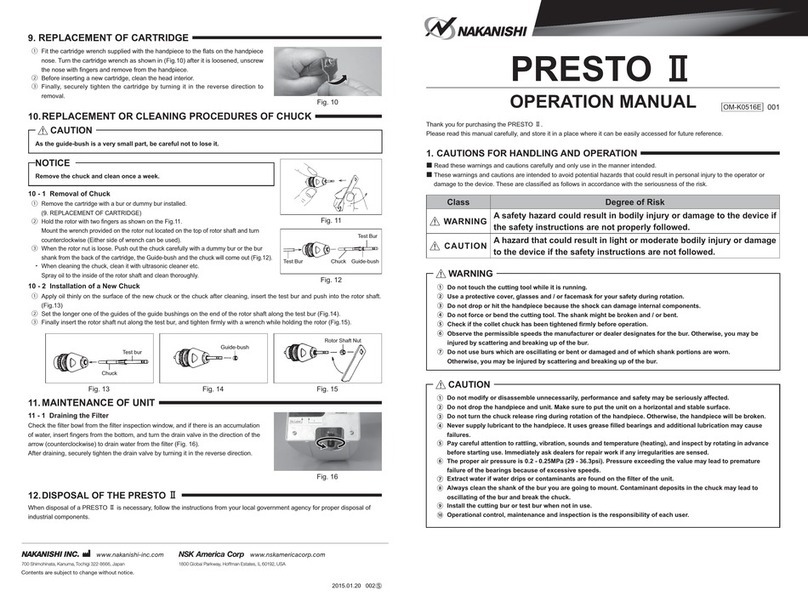
Nakanishi
Nakanishi PRESTO II Operation manual

Endress+Hauser
Endress+Hauser Analytik Jena UVP Transilluminator instruction manual
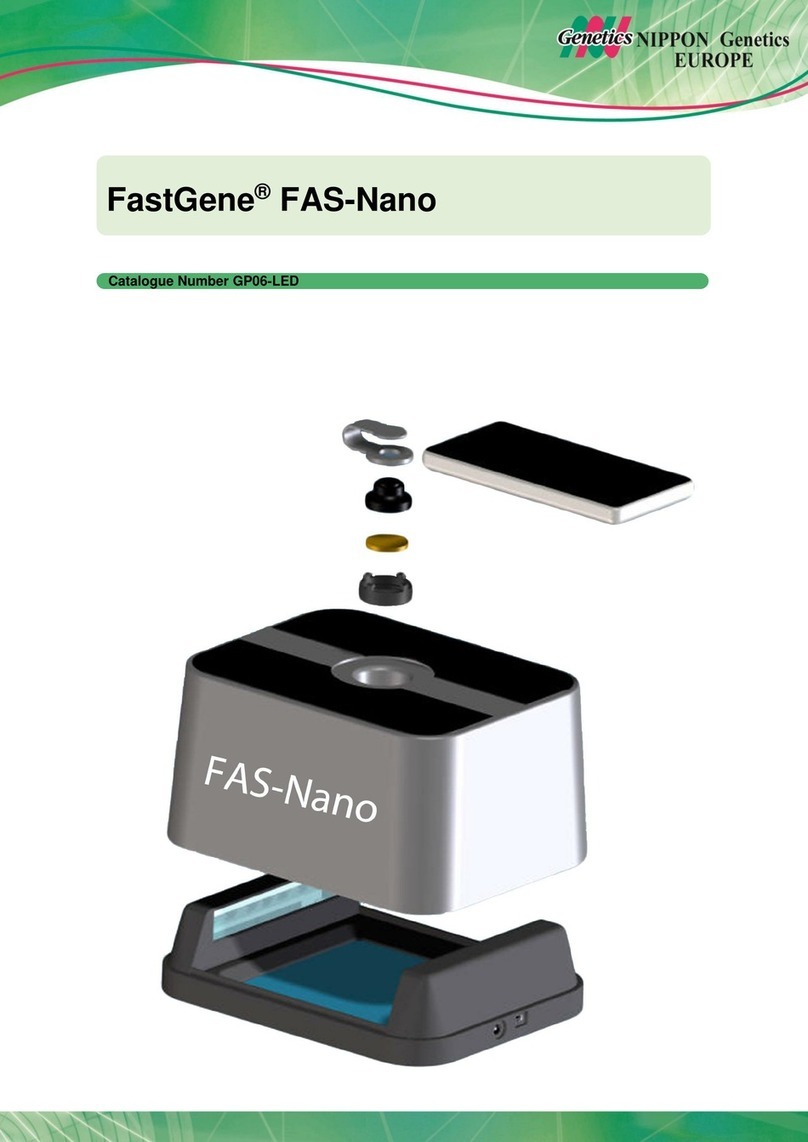
Nippon Genetics Europe
Nippon Genetics Europe FastGene FAS-Nano GP06-LED quick start guide

ELGA
ELGA CENTRA S200 US Operator's manual
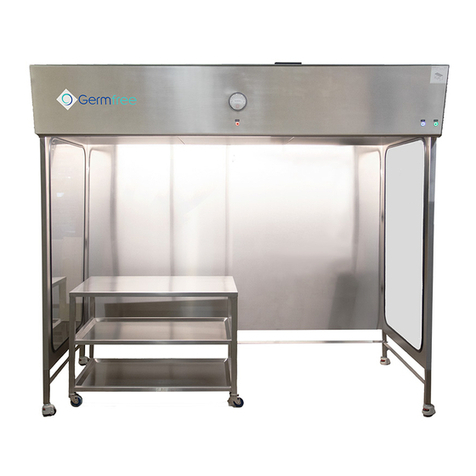
Germfree
Germfree LAF user manual
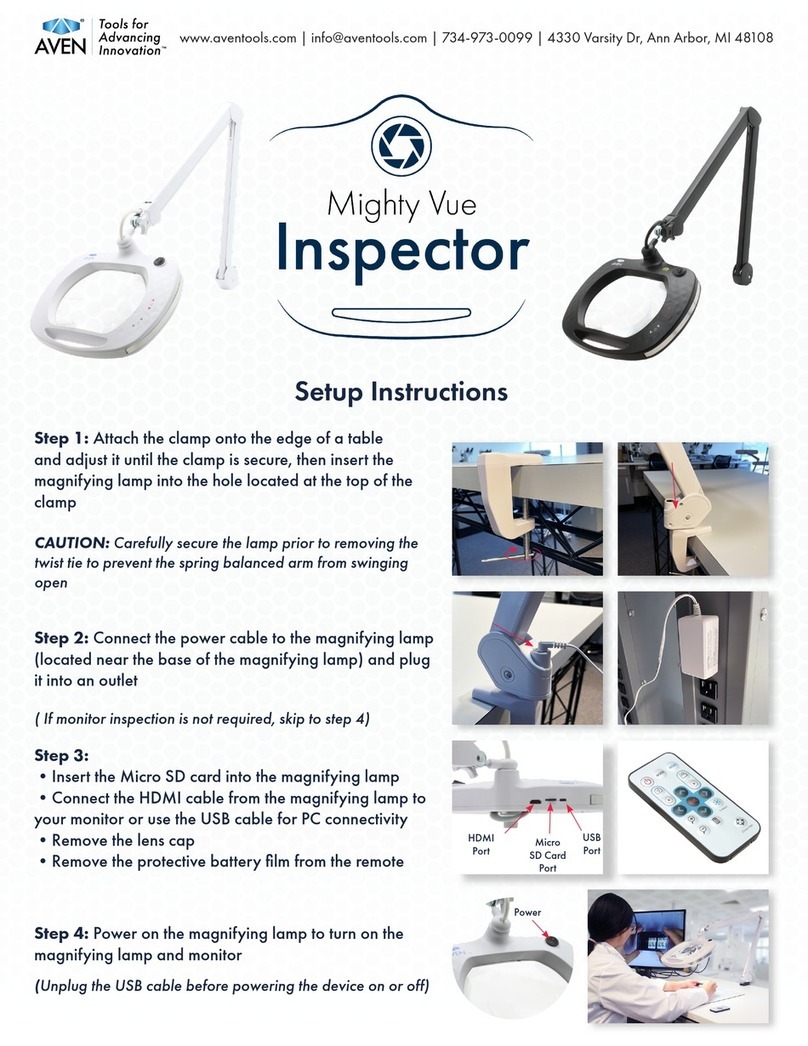
Aven
Aven Mighty Vue Inspector quick start guide
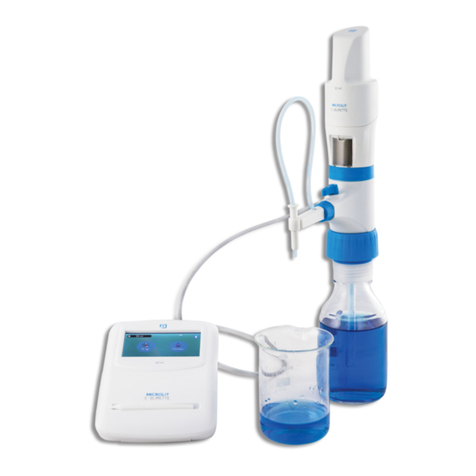
MICROLIT
MICROLIT E-BURETTE Product guide
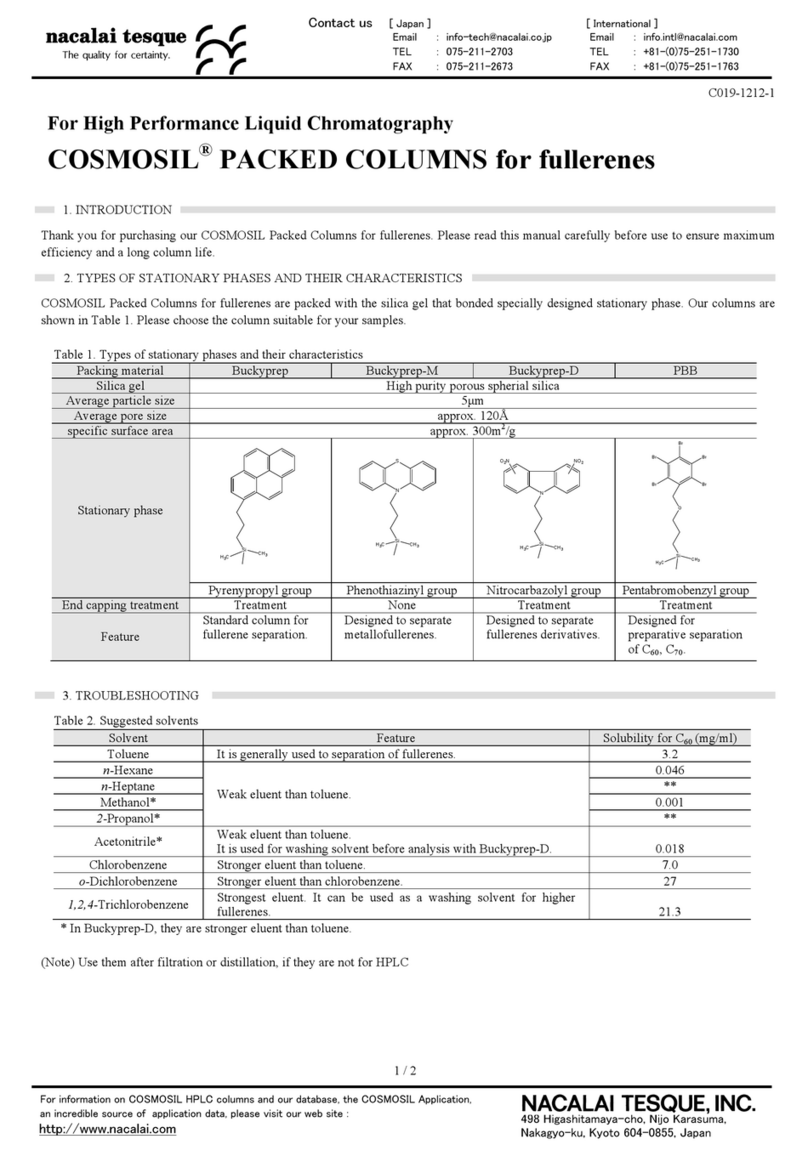
NACALAI TESQUE
NACALAI TESQUE COSMOSIL HPLC quick start guide

Endress+Hauser
Endress+Hauser Liquistation CSF48 technical information
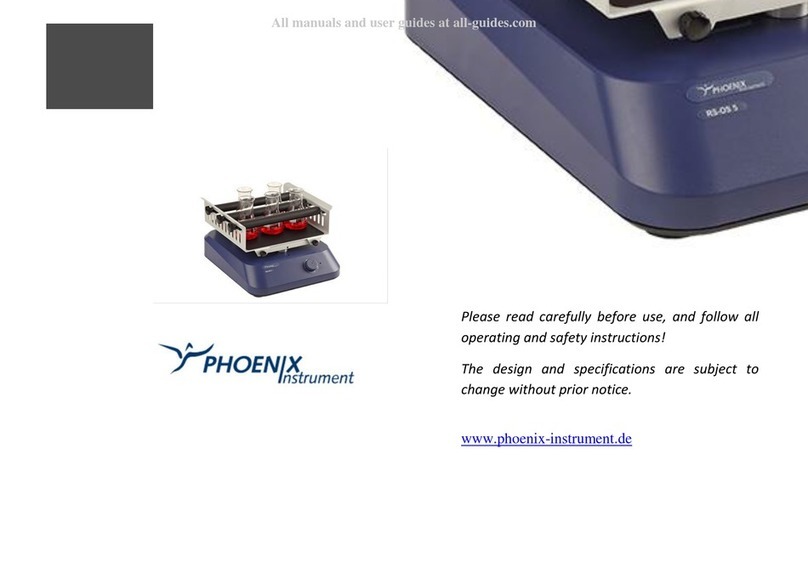
Phoenix
Phoenix RS-LS5 manual

PASCO
PASCO PK-9023 Instruction manual and experiment guide
